





















































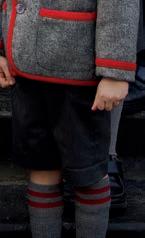








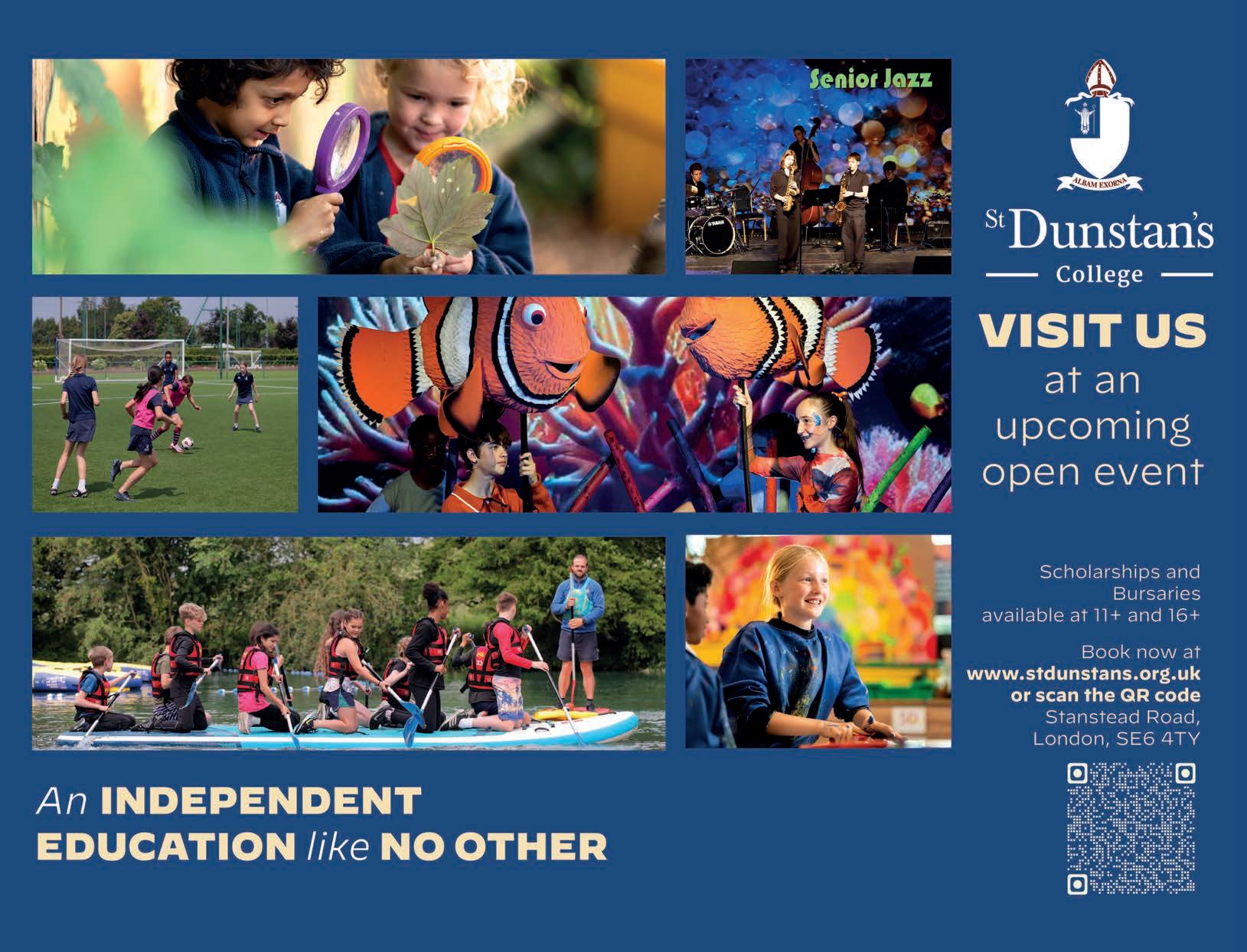





educator
With a background in EYFS teaching across Kent, Sophie David is now an early years consultant, author, and the founder of the Little Happy Learners platform of resources for young children and their carers. In this issue, she talks about her new book on phonics, Read, Write, Play, and her broader mission to make early reading and writing playful, active and hands-on, so that adults and children can share enjoyable and productive time together.

Head of Student Wellbeing & Head of Drama, ISL



With a BA in Literature and Theatre from the University of Lyon, Benoit Gouttenoire chose to relocate to London, establishing himself as an actor, theatre director and educator working across the UK, France and Greece. He has a PGCE and MA from UCL and also graduated from the Tavistock and Portman Centre in the field of Child, Adolescent and Family Wellbeing. In this issue, he discusses why the IB Diploma is such a powerful vehicle for helping students to develop their leadership qualities.

Illustrator and author
Jess Hannigan studied illustration at Sheridan College, Ontario and lives and works in Hamilton. She has illustrated for the New York Times, Washington Post and Readers Digest Canada – also creating memorable 20th-anniversary artwork for the Green Man Festival in the Brecon Beacons. In this issue, she discusses her latest children's picture book, the importance of delivering plots that are fun for both children and adults and why – in a digital age – it's a joy to create artwork the old-fashioned way.
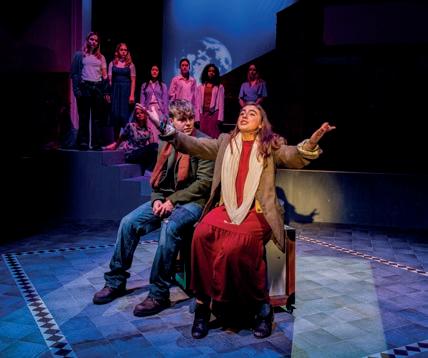

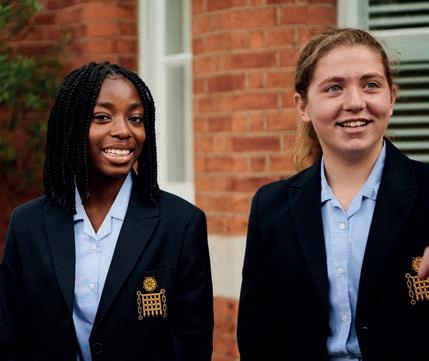
















Assistant Principal, Concord College
Orlagh Hotchkiss studied Acting at Northampton University and completed her PGCE and Masters in Teaching and Learning at Birmingham City. She joined Concord in 2018 as teacher of Drama and took on roles as a Head of House and Head of Year before being appointed Assistant Principal (Co-curricular, Outreach and Inclusion) in 2024. In this issue, she talks about the role of outdoor education in helping young people relate to each other, take risks and achieve things they never thought were possible.



Author
Originally from County Louth, but now a convert to County Donegal life, Meg Grehan wrote prolifically as a child and then returned to it in her early 20s. That book, The Space Between , won a 2018 Children's Books Ireland Award – four books have followed. With a large international audience, she has picked up a string of plaudits, including nominations for the Carnegie Medal and Waterstone's Children's Book Prize. In this issue, she talks about her new novel and why she loves writing in the verse form.

Christian San José Headmaster, Wycliff e College
Christian San José studied Geography at Oxford and trained at Sandhurst, serving in the Army with the Royal Green Jackets (The Rifles) before moving into education. He was at Radley for eleven years before being appointed Senior Deputy Head at Giggleswick School in 2021. He joined Gloucestershire school Wycliffe as Headmaster at the start of the 2024-5 academic year. In this issue's 60 Seconds profile, he describes his background and educational philosophy.

AN INDEPENDENT BOARDING AND DAY SCHOOL FOR GIRLS AGED 11 TO 18







“EXCEPTIONAL QUALITIES OF COMPASSION AND CARING.”
ISI
REPORT



OUTSTANDING ACADEMIC RESULTS • SCHOLARSHIPS AVAILABLE EXTENSIVE CO-CURRICULAR PROGRAMME STATE OF THE ART EQUESTRIAN CENTRE SET IN THE BEAUTIFUL SUSSEX COUNTRYSIDE FLEXI, WEEKLY AND FULL BOARDING OPTIONS
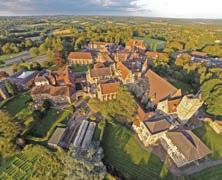





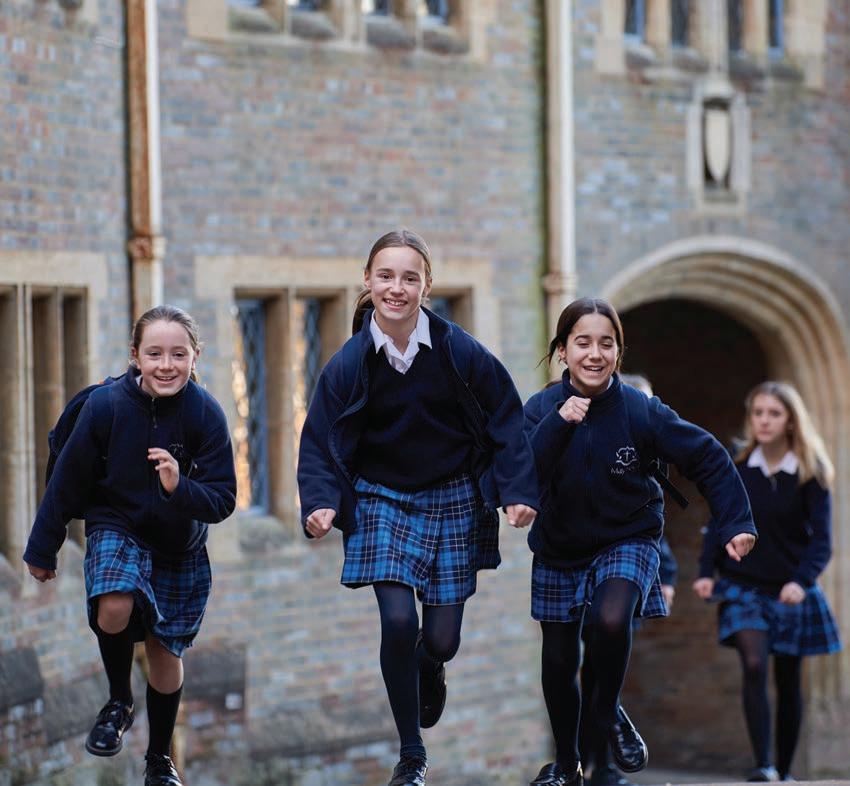

Open Morning
FRIDAY 19 TH SEPTEMBER 2025
TO ARRANGE A VISIT PLEASE CONTACT MRS SHIRLEY COPPARD, REGISTRAR@MAYFIELDGIRLS.ORG
Summer brings the agony and the ecstasy for many parents – living through someone else’s exam season is almost worse than your own. It’s also a time of planning for transitions, be it taking that first small step into nursery or that epic jump up to university.
This issue, we run the full gamut from 3-18+, with plenty of insights and inspiration from education insiders. Our cover feature about Inspired Education Group (page 26) explores exciting new school choices for London parents. Its new Wetherby Pembridge Senior opens in Kensington Olympia this September, a landmark school in a wonderful central location to provide
In Service culture (page 66), we ask three schools about the value (and values) of extracurricular activities such as CCF, DofE and volunteering. Perhaps the first two were once seen as largely the preserve of independent education, but thankfully these days there’s a much wider understanding, and also a growing recognition of the huge value of service activities within education. The skills and attributes they teach – from teamwork and leadership to self-esteem –give young people a much clearer sense of what they can achieve in the world beyond classrooms. And that, surely, is the whole point of education.
Summer stretches forever when you’re at school, and we have some great ideas to occupy those glorious days o . Our summer book selection (from page 110) provides
“THERE’S A GROWING REALISATION OF THE VALUE OF SERVICE ACTIVITIES – THE SKILLS AND ATTRIBUTES THEY TEACH GIVE YOUNG PEOPLE =A CLEARER SENSE OF WHAT THEY CAN ACHIEVE”
21st-century resources alongside the Wetherby hallmark of academic excellence.
We visit the Hackney School of Food (from page 36), a place that is transforming attitudes through the natural processes of growing, cooking and eating together. It delivers important education around food, but also engages children by opening up a di erent perspective on the world. And we talk to four schools about the enduring power of cricket (page 58). The great summer game is anything but sleepy, with new formats and an encouraging rise in both female players and pathways for their talent.
great escapes for days in the garden, and we explore the brilliant work of Canadian illustrator-author Jess Hannigan (page 108).
If you’re thinking bigger on escapes, don’t miss our guide to six of the best British campsites (page 120), our review of Wymara on – arguably – the world’s best beach (page 124) and our visit to the delightfully quirky home town of Lego (page 128). Enjoy your summer days o .
Libby Norman EDITOR
What’s
Francis Holland won a prize for its floral 'Fearless Girl' 20
Marymount International School London's pioneering approach to girls' education
Inspired Education Group o ers outstanding all-through school journeys 36
Hackney School of Food's magical seed-to-fork experiences for children and community
Three preps share how they grow their own and the pleasures of the school plot
58
Summer's great game is going strong thanks to new formats and commitment to developing players



















Real-life value comes from CCF, DofE and volunteering – three schools explain why 73 MORE THAN SPORT
Loretto on why golf is a winner for students
St David's College on the true value in scholarship programmes 81
London Park Schools on extracurricular success
87
Beating the back-to-school blues 91
Your education questions answered
Building experience to stand out from the crowd
101 POISON IVY?
The long view on applying to Ivy League universities 103
A smart way to travel as you earn
















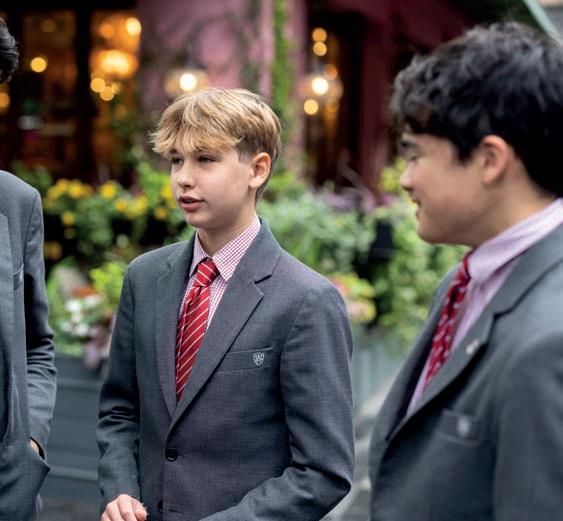




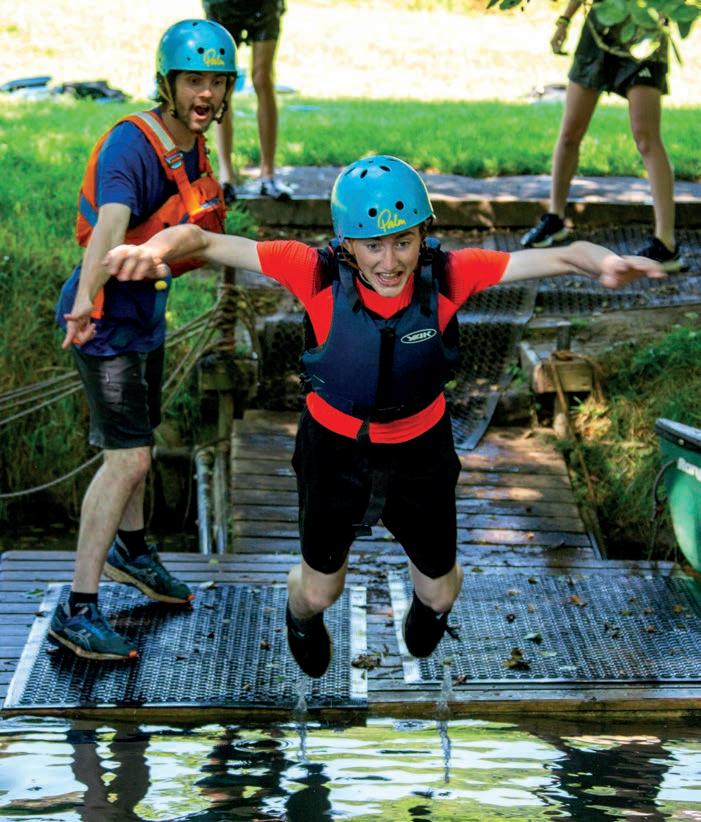
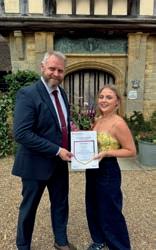
Hurtwood House has cemented its position as ‘best school for Media Studies’ for the second year, with student Evie achieving the top mark in the world. Evie, who is off to IE Business School, Madrid, was presented with a certifi cate by her teacher Stuart Butcher. In all, 23 of this year’s Media A-level students earned A* grades.
“Evie is top in the world for Media Studies A level –and 22 Hurtwood classmates also earned an A* grade”






Moor Park School staged a large-scale production of Shrek the Musical JR . for students in Years 6-8, bringing the characters of Shrek, Fiona, Donkey, and others to life with enthusiasm and professionalism. “The energy and enthusiasm from everyone – on and off the stage – was simply amazing,” says Moor Park Head of Performing Arts Toby Dunham.


Dulwich College hosted the national round for the international physics challenge, the Weizmann Safecracking Competition, with its own team achieving fi h in this tough event. With 21 safes entered by students from 16 different schools, the competition tested creativity, engineering skills and problem-solving abilities – also requiring exceptional teamwork.
James Pater, Upper Sixth pupil at The Leys, has signed his fi rst professional contract with the Northampton Saints. This milestone comes a er representing England U18 in the Six Nations this year, earning caps for England U19 and leading The Leys to victory in the Uppingham Sevens tournament. “It is a dream come true,” he says.







Queen Anne’s School (QAS) celebrated a er its U19A lacrosse team were crowned champions at the National Schools Lacrosse Tournament. QAS fought through two days of competition to secure the title for the fi rst time in nearly 30 years, the win being secured a er a hard-fought 3-2 victory over St Catherine’s, Bramley.
“The human mind has not achieved anything greater than the ability to share feelings and thoughts through language”
JAMES EARL JONES


Feltonfl eet’s Digital Prefects confi dently demonstrated the school’s own AI-powered learning assistant, RileyBot, at a recent meeting of Pre Senior Baccalaureate (PSB) schools to discuss Artifi cial Intelligence in education. Leading discussion and answering complex questions, the Year 8 pupils showcased how pupil voice and digital leadership are shaping the future of education.


Queen Ethelburga’s Collegiate has a new driver for the CityCar Cup Championship, incorporating the Student Motorsport challenge 2025. Emilia Vincent, an ex-Motorsport Engineering student from Wiltshire College, brings a wealth of experience. The Collegiate launched this as an extracurricular option in 2022 – you can follow the team at @qemotorsports.
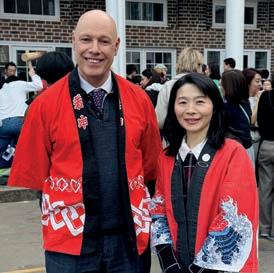

Mill on the Brue activity centre off ers lots of fun adventures, but it’s also celebrating its Zero Heroes food waste policy (no food waste a er meals), now running for over a decade at the site. It’s one of many green initiatives, including ongoing tree planting and a coach escort from London to Somerset for Summer Camps.







Wellington student Momo X has won a host of awards for his photography, featured in his book, The Art of Small His passion for ‘ultra-macro’ photography started young, and at 15 he became the youngest Chinese photographer to appear in National Geographic

From September, the International School of London will offer secondary students (11+) a Japanese language acquisition option, alongside French, Spanish and Mandarin. ISL Head Richard Parker (pictured with teacher Tamako Matsukuma) says it sits alongside 24 home languages already at the Chiswick school.



















“How very little can be done under the spirit of fear”

“THE MOST DIFFICULT THING IS THE DECISION TO ACT, THE REST IS MERELY TENACITY”





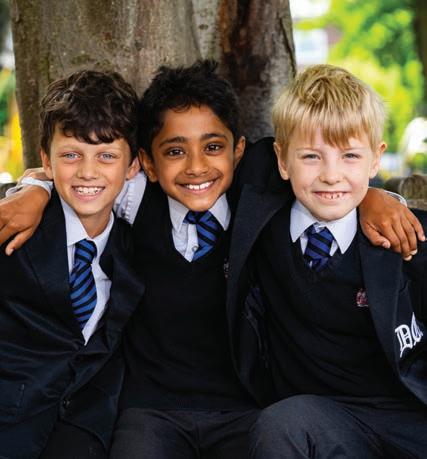












Malvern School teenagers braved soaring temperatures to race some 200 miles against the sun with no technology or navigation aids. The pupils, all aged 14 and 15, participated in the fi rst ‘Race the Sun’ from Kent back to the Malvern Hills, collecting for charity along the way. The top three teams were all female.
St Benedict’s School in Ealing has announced that pupils in the Junior School will no longer sit the 11+ entrance exam for transferring to its Senior School from September 2025. It says this allows students to maintain momentum in learning and ensures a smooth, confident transition. The decision followed a consultation with parents, who were overwhelmingly in favour.





Bedford School Sixth Form student Alex Lamb reached the fi nals of the Pupil Library Assistant of the Year Awards (PLAA). The award celebrates pupil librarians across the UK and he was nominated by the school’s Library and Information Manager Lauren Chatley. “It is testament to Alex that he fi nds himself on this year’s list,” she says.
Moulsford Prep in Oxfordshire has brought forward the next phase of its co-ed plans and will begin welcoming girls into Year 3 (age 7) from September, a year ahead of schedule. The school has been busy preparing facilities, curriculum and training in readiness for the new cohort. Moulsford Pre-Prep has already moved to co-education.
Haberdashers’ Elstree Schools raised £190,000 for bursary and hardship schemes during a giving day in April. This year’s focus was on helping current students. There were fun runs, including the GivingDash to run 3.5km and unlock extra donor funds. Further MiniDash and TinyDash events took place for the youngest pupils.
Stephen Perse Cambridge girls’ football team won the national Independent Schools Football Association U15 Girls Shield. A er securing victories in the fi rst four rounds, the girls beat St Dunstan’s College 3-1 in the fi nal. “They are now looking forward to building on their success,” says Deputy Head of Co-Curricular Jenny McLeod.
Parents in the British Army, Navy, Marines and RAF will pay just ten per cent of school fees for their children boarding at Felsted School from September. With one of the oldest CCF contingents in the country, the Essex school has a long tradition of welcoming Forces families and those in receipt of CEA will be eligible.






“THE MORE YOU DO SOMETHING, THE LESS FRIGHTENING IT BECOMES BECAUSE YOU START TO REALISE THE OUTCOME IS NOT AS IMPORTANT AS YOU THINK” HUGH JACKMAN




















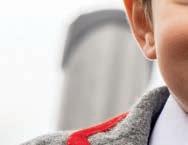
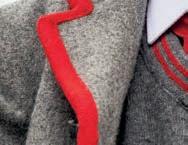














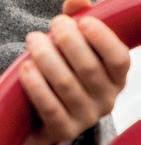


www.wetherby-kensington.co.uk

Francis Holland Prep created a ‘Fearless Girl’ recreation in flowers and picked up a coveted Chelsea in Bloom Gold
Francis Holland Prep’s floral interpretation of this year’s Chelsea in Bloom ‘Flowers in Fashion’ theme picked up a Gold, to the delight of pupils and sta in both Prep and Senior schools and the parent body. For this was very much a team e ort.
The starting point and inspiration for the design was ‘Fearless Girl’, a symbol and uno cial mascot of both Francis Holland Prep and sister senior Francis Holland, Sloane Square, a short walk up the King’s Road. The design was inspired by Kristen Visbal’s bronze statue which stands in New York – an o cial replica is on display at Francis Holland, Sloane Square.
This wonderful floral version was covered entirely in moss and flowers, a book held firmly in her hand and wearing the school’s distinctive uniform of tartan skirt and navy jumper. Dressing the historic entrance to the Prep at 15 Manresa Road – once home to the Chelsea Public Library – the design incorporated dried, fresh, and handmade

“The outfit for this floral Fearless Girl incorporated dried, fresh and handmade flowers”
flowers. The handmade blooms were carefully curated by Francis Holland Prep pupils. In late May, the school was delighted to hear that this bespoke design had
not only won a prestigious Gold Award (only 14 out of 130 participants were awarded a Gold) but also a special mention for the Innovation Award. The Chelsea in Bloom judges commented on both the creativity and the sustainability of the installation – particularly pupils’ handmade flowers, which were made from upcycled school uniforms. The girls had chosen this approach to underline the vital importance of sustainable fashion.
The winning design was a real group e ort. FHS parent Lola Cavanilles, an artist, interior and flower designer, gave generously of her time and expertise, and many other parents, sta and pupils spent hours on the planning, design and final installation.
The school was especially delighted to be among the winners with so many other superb entries by Chelsea in Bloom participants. Following this success, Francis Holland Prep and Senior girls hope to take part in in many more local community events and challenges – and do so fearlessly.

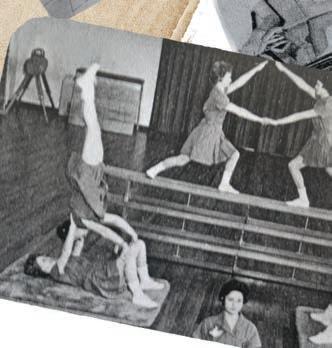





Now entering its 70th year, Marymount International School London was established as a place to educate forward thinking young women. An IB school, with students from around the world, it remains true to its founding vision to transform lives through education






“
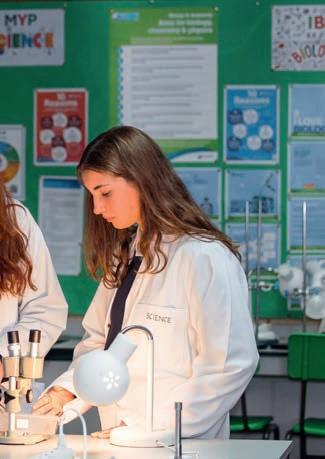
Marymount International School London was founded in 1955 by the Religious of the Sacred Heart of Mary (RSHM), a Catholic order that believes deeply in the power of education as a transformative force. It put down roots in a beautiful Edwardian property located just twelve miles from central London.
The RSHM has historically recognised the need to empower young women; its Founder Mother Butler established Marymount School of New York in 1926 with a clear objective. “The aims of a Marymount education are manifold: to educate the heart and mind, and to provide for each student’s total growth, intellectually, spiritually, and physically”. A farsighted visionary, Mother Butler created a heritage of innovation, dynamic leadership, and compassionate citizens for future generations.

It was out of this vision that young women were encouraged to seek an international education, and Marymount London was created to promote active global citizenship. Far from being theoretical, global mindedness is lived every day at Marymount. Students speak di erent languages, celebrate di erent festivals and cultural events, and learn from each other in the most natural way – by living and learning side by side.
From its foundation in 1955, the school focused on both depth and breadth of academic knowledge –unusually for the times, o ering girls subjects such as law, economics and science. But this was more than a place of knowledge, it was a home for values. The school’s vision: ‘That all may have life and have it to the full’ has stood as a guiding light for generations of Marymount students ever since. The commitment to educating the whole person – mind, body, and spirit – is a thread that has defined its approach academically, too. In 1979, Marymount became the first girls’ school in the UK
to adopt the IB Diploma programme. The IB’s philosophy and methodology sit naturally within an internationally minded and values-based school. In 1995, Marymount also adopted the IB Middle Years Programme for students from 11-16. This required a robust approach to design and delivery in order to provide a meaningful, sustained experience. Marymount took this important decision with the strong belief that these formative early years of senior education help establish an approach that underpins all future educational exploration and supports academic success. The MYP aligns with Marymount’s foundational values and vision but has also shown its worth in preparing students for the rigours of the IB Diploma Programme – results place this school, just twenty minutes from the centre of London, among the top 2% of IB schools globally.
Marymount London has always looked outwards, and nowhere is this more evident than in the school’s participation in the RSHM Global Network. Annual RSHM Festivals, such as the Sports Festival and Model United Nations give the school’s MYP students a platform to meet their peers from around the world, exchange ideas, showcase talent and explore solutions to shared global challenges. Such experiences are transformative,


exposing students to the richness and complexity of the world through travel and a meeting of minds. As the RSHM puts it: ‘Di erences are not to be feared – they are to be celebrated’.
The Marymount experience extends far beyond the years spent on campus. The alumnae network is a testament to a rich shared history and an enduring bond. Alumnae return not only to visit, but also to share their lives, contribute to current programmes and continue the cycle of mentorship and mutual growth.
The school’s ‘live life to the full’ vision speaks to the belief that education should not just equip students to pass exams or climb career ladders. It should help them become fully human – thoughtful, kind, questioning, resilient. Marymount students are not taught to chase status but are invited to become the kind of people who make the world a better place.
Sister Mary Jo Martin, Global Network Co-ordinator of the RSHM, says: “Marymount is, at its core


and in its history, an invitation. It invites students from all backgrounds to enter a community shaped by faith, values, curiosity, academic rigour and lifelong learning. It invites young people to explore the world – not just geographically, but intellectually, culturally and spiritually. And it invites every learner to deepen their sense of what it means to live with integrity, courage and joy”.
As the school moves into its 70th year, that invitation to explore feels just as relevant and necessary as
ever – perhaps even more so. The roots planted in 1955 continue to flourish – not just in the halls and classrooms of Marymount, but in the lives of its students, teachers and alumnae living and working across the globe. The mission and vision of Marymount International School London remain as strong as they were when Mother Butler first imagined a better world through the power of education. As RSHM’s
Sister Mary Jo puts it: “Marymount remains a school where life is lived –and lived to the full”.
“GLOBAL MINDEDNESS IS LIVED EVERY DAY AT MARYMOUNT, WHERE STUDENTS SPEAK MULTIPLE LANGUAGES, CELEBRATE DIFFERENT FESTIVALS AND LEARN FROM EACH OTHER”

teach differently





learn differently

think differently
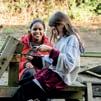








teach differently
learn differently




think differently

learn differently

learn differently




teach differently





think differently




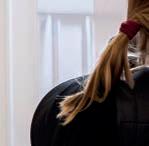


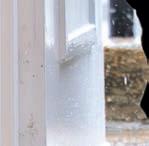





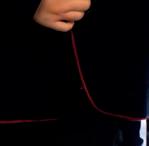




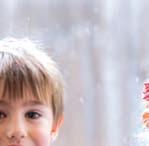


























With Wetherby Pembridge Senior opening in September, and new Pre-Prep classes arriving in 2026, Inspired Education Group now o ers a continuous school journey for London students
– and with a clear focus on academic
excellence
This September, the Inspired Education Group is opening its state-ofthe-art, co-educational senior school – Wetherby Pembridge – in London’s Kensington Olympia. Here, the best of traditional education will meet the future of learning. The school will enhance Inspired’s senior school o ering in the UK, adding to the existing Wetherby Senior School in London and Reddam House School in Berkshire.
Meanwhile, in September 2026, Inspired is launching an exceptional Fulham Pre-Prep in a new location, and additional Pre-Prep classes at Wetherby
Prep in Marylebone. This means three Wetherby Schools in three London locations, all with the same academic rigour and outstanding results.
These additions ensure the central London o ering will be available to more of the youngest learners , giving more choice to parents, with a continuity of academic excellence across all age groups.
Continuity in the learning journey o ers many benefits for children, not least consistency of care and stability. Schools within Inspired have a full picture of each child, their family and their educational journey to date.
The proximity of this group of leading independent schools across the capital
ensures that students and their families benefit from enhanced connections and lifelong friendships within a supportive and active London learning community. They also have access to almost 15 acres of premium sporting facilities at Wetherby Pembridge Sports Ground Wood Lane. As a part of the Inspired community, families gain many other benefits. They include opportunities for children to join Inspired's renowned global camps, and potential exchanges across the 119 schools within the group. These prestigious schools span Europe, the Middle East, Africa, the Americas and Asia Pacific regions, and with an additional Inspired online school.
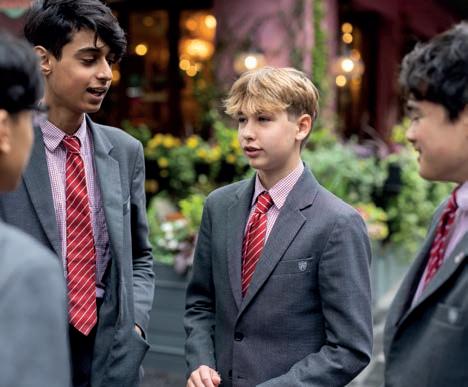
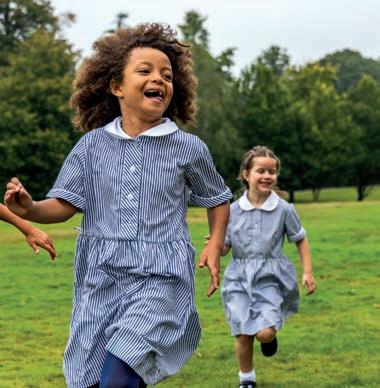
“ WE MAKE IT OUR MISSION TO KNOW AND CARE FOR EACH CHILD AND HAVE THEIR BEST INTERESTS AT THE HEART OF EVERYTHING WE DO”
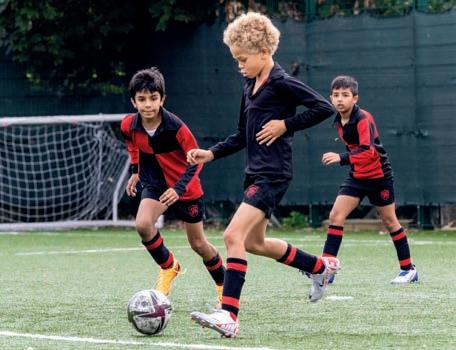
Inspired’s schools are recognised worldwide for their academic and cocurricular excellence and for producing exceptional outcomes. Last year, for example, students received 114 scholarship o ers and places at prestigious universities around the world, including Imperial College London, University of Cambridge, Durham University, Princeton, NYU and Bocconi, Milan.
Inspired has been consistently recognised over the past 15 years within education. Its UK schools have received a host of prominent industry awards, including the ISA Junior School of the Year (Fulham Prep), Tatler Prep School of the Year (Wetherby Prep), Talk Education Innovation in Education award (Pembridge Hall), Best Company Award at the Young Enterprise competition (Wetherby Senior), and Tatler’s Lifetime Achievement Award (Mark Snell, UK Director of Education and formerly Headmaster at Wetherby School).
“With the opening of Wetherby Pembridge in September and the new

Pre-Prep o erings at Fulham Prep and Wetherby Prep in the year to follow, we are excited to be expanding our o ering across London to provide access to the highest academic standards and curriculum rigour at all levels, from Early Years to Sixth Form," says Kathleen Mitchell, UK CEO of Inspired Education.
“Being part of the Inspired group of schools means that students benefit from a robust, holistic curriculum formed around Inspired’s three pillars of modern education: academic excellence, sports, and performing and creative arts, with dedicated, highly qualified specialist
teachers who deliver outstanding education," she adds.
“At Inspired Education, our focus on the continuous learning journey helps to provide a full picture of each child and their education journey to date," says Mark Snell, UK Director of Education. "We make it our mission to know and care for each child and have their best interests at the heart of everything we do.”
The Inspired story
Inspired Education Group provides a premium education at 119 schools to more than 95,000 students on six continents.
Inspired utilises the best educational practices from every corner of the globe to ensure that each student in its care receives a first-class learning experience – from Kindergarten to Year 13.
Students benefit from a robust, holistic, international curriculum formed around Inspired's three pillars of modern education (academic excellence, sports, performing and creative arts) and with a curriculum delivered by dedicated and highly experienced specialist teachers.
For more information about Inspired, visit inspirededu.com
“ WE ARE EXCITED TO BE EXPANDING OUR OFFERING ACROSS LONDON TO PROVIDE ACCESS TO THE HIGHEST ACADEMIC STANDARDS AT ALL LEVELS, FROM EARLY YEARS TO SIXTH FORM”


Holland Park Gate by Lodha is Kensington’s favourite family development, preferred by parents for its proximity to many of London’s top schools as well as Holland Park’s 54 green acres. Enjoy a joyful, balanced and fulfilling family life with additional household amenities including:
• Kids’ club for fun & education
• Dedicated house car for school runs
• Weekly school uniform laundry services
• Partnership with leading educational consultancy


scan to expore: @lodha_uk hollandparkgate.com


Alex Murphy, Deputy Head of St Dunstan’s College Junior School, on how this award-winning prep prepares young people for the world of tomorrow
In independent education parents, understandably, want to see value for money. With rising fees driven by VAT changes and a cost of living higher than many have ever known, the return on investment in private schooling is under greater scrutiny than ever. Schools often point to league tables, exam results, and university destinations to highlight their success, but do these metrics tell the full story? And are they overshadowing something just as important – the development of the individual?
Academic achievement matters. It equips children with the knowledge and skills to access broader opportunities beyond school. Yet on its own, it is not enough. Without the ability to think critically, collaborate and
self-reflect, academic results risk becoming hollow credentials. Today’s employers are less interested in specific exam grades and more focused on whether young people can learn independently, adapt to change and lead with confidence and integrity. Given the unpredictability of the future job market and the rapid pace of change, two skills stand out in particular: critical thinking and problem solving.
These human and cognitive skills aren’t easily measured. They don’t fit neatly into a spreadsheet or performance report. Instead, they are embedded in classroom interactions, pastoral care and the broader educational ethos – from the earliest years onward. Schools that embed this philosophy early on, rather than waiting
“A rich character education nurtures emotional intelligence, moral awareness and a sense of purpose”
until secondary education, are becoming increasingly attractive to families. More parents are choosing schools not just for their rankings, but because the school’s values resonate with their own.
Junior school pupils are at a formative stage. Every interaction – whether it’s navigating a playground disagreement or reflecting on a mistake – shapes their character. These early years are when empathy, resilience and integrity take root. If schools focus solely on academic benchmarks, they risk producing highachieving children unprepared for life’s complexities. Schools that recognise this and adapt their curriculum to include life and metacognitive skills give children the space to forge their own path. They help them find their voice, understand who they are and build the character needed to make a meaningful impact beyond education. A rich character education nurtures emotional intelligence, moral awareness and a sense of purpose. These qualities matter just as much as grammar or times tables.
These qualities must not be treated as tokenistic extras. When integrated fully into a learning journey, they help children discover who they are, what they value, and how they can contribute to the world. That is the true value of education and the greatest return on investment.
Find out more about St Dunstan’s College Junior School at stdunstans.org.uk


Benoit Gouttenoire, Head of Student Wellbeing & Head of Drama at ISL London, on how the IB teaches students to lead themselves so they can also lead others
In my years at ISL, I’ve realised that education encompasses more than just academic success. It’s about preparing young individuals to lead meaningful lives. Ever since I began teaching the IB Diploma in 2007, I’ve seen it as a framework supporting this philosophy. It fosters leadership, resilience and lifelong learning – which are all crucial traits for students to develop.
One of the tenets of our role as educators is modelling for our students how to become leaders – not just leading others but leading themselves. Leadership starts with selfawareness, emotional intelligence and the ability to reflect on our actions and choices. The IB presents daily challenges but also inspires students to look inward and envisage their potential as leaders through, for example, the Creativity, Activity and Service (CAS) elements of the programme.
As Head of Drama, I see how the arts provide an ideal platform to develop leadership qualities. Drama focuses on core values such as communication, empathy, self-confidence and resilience – essential for leadership in all areas of life. Supporting a drama student to take risks and find their voice while collaborating with others fosters critical thinking and creates a safe environment of respect and inclusion.
However, leadership cannot exist in a vacuum. It needs a foundation of wellbeing, an essential nurturing ‘umbrella’ above each student. It’s not merely about addressing emotional struggles, but about making each student feel safe, heard, valued and protected until they gain the confidence to carry their own umbrella. E ective wellbeing does not stop the rain falling,
“The IB inspires students to look inward and envisage their potential as leaders”

but it does keep us dry. A personalised approach to pastoral care is vital because every student has unique strengths and challenges. Educators must explore and support this individuality to help students navigate the complexities of life.
My own journey as a lifelong learner, enriched by my studies in systemic and psychodynamic psychology at the Tavistock and Portman, has shaped my understanding of how to nurture curiosity and growth in students. My grandfather Charles once gave me advice: “keep your ears in the direction you are walking”. This simple statement is a reminder to stay focused and grounded in values while remaining open and mindful.
Educators should help students develop this kind of awareness, showing young people how to cultivate purpose and direction while also being realistic about challenges.
The IB’s principle of lifelong learning encapsulates this beautifully. Our responsibility as educators is to help students realise that learning continues beyond graduation. We must help them recognise that learning is a continuous
journey. It’s often the company along this journey – those around us who o er support and understanding – which makes a significant di erence. A culture of care is essential to create a learning environment where students feel secure enough to take risks and grow.
Ultimately, our shared educational goal extends beyond producing high-achieving students. We aim to nurture well-rounded, thoughtful individuals who lead with purpose and empathy. And, by placing wellbeing and lifelong learning at the core of education, we also equip them with the necessary skills to navigate an increasingly complex and uncertain world.



Wetherby Pembridge draws on the established rigour and academic traditions of Wetherby and
Hall, blending time-honoured values with an innovative, forward-looking education. Students are prepared to lead—not just in the classroom, but to make a lasting, positive impact on the world around them.
Naomi
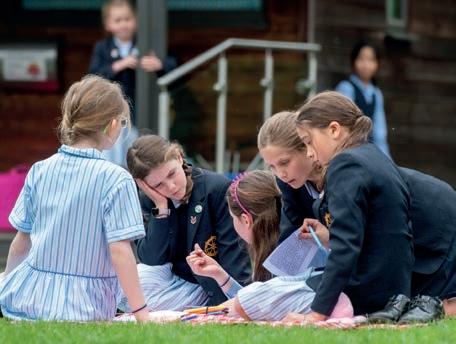
At St Catherine’s Prep School in Bramley, we are advocates of girls only education. So why do we recommend that girls are educated separately during their formative years? In a world increasingly focused on equity, opportunity, and inclusion, it might seem counterintuitive to advocate for single-sex education. Yet, time and again, I witness how a girls only environment o ers a powerful foundation – not only academically, but also socially and emotionally.
The early years of a child’s education are crucial. These are the years when personalities are formed, values embedded and self-belief built. We can tailor every element of school life to the way that we know – and research endorses – that girls learn best. This ranges from classroom dynamics and curriculum choices to extracurricular and leadership opportunities.
Girls are known to thrive in environments where collaboration, creativity and communication are at the heart of learning.
At St Catherine’s, we nurture these traits while also providing the structure and challenge that encourage girls to take risks, make mistakes and grow in confidence. In a girls’ environment, pupils feel uninhibited by traditional gender stereotypes. Girls are the priority in every lesson, every club and every sport. They become scientists, coders, engineers, debaters and leaders in their fields – not because they are exceptions, but because they are expected to.
Research continues to support what we observe daily – that girls in singlesex schools are more likely to pursue STEM subjects, feel more confident in expressing themselves and take on leadership roles without hesitation. Free from comparison or competition with boys, they are more likely to find and use their voices early. These are skills that last a lifetime.
Crucially, this environment also allows us to address the
“Girls leave us as confident, articulate and intellectually curious individuals –they know their worth”
emotional and psychological needs of girls as they grow. We understand the social dynamics that can shape girls’ experiences and provide thoughtful, structured pastoral care to help them navigate friendships, selfimage and resilience. We teach them how to speak up for themselves and others, how to recognise healthy relationships and how to embrace who they are.
Of course, we are preparing girls for a world that is very much ‘co-educational.’
That’s why our curriculum incorporates diverse perspectives and our enrichment programme o ers ample opportunity to collaborate beyond the school gates –whether through joint initiatives with boys from local schools, community projects or wider partnerships. What we o er is not insulation from the world, but preparation for it, grounded in the strong sense of self that an all-girls’ setting uniquely cultivates.
At St Catherine’s Prep, our girls leave us at age eleven as confident, articulate, and intellectually curious individuals. They are ready to take on the challenges of senior school and beyond, not because they’ve been sheltered, but because they’ve been empowered. They know their worth, their capabilities and their place in the world.

The benefits of a girls only primary education are profound and enduring. It’s not about removing boys from the equation – it’s about placing girls firmly at the centre of it.
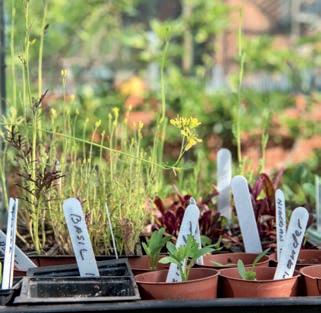
The opening of the Garden Room at Hackney School of Food means children and community can enjoy even more inspiring seed-to-table experiences
LIBBY NORMAN
There's something magical about Hackney School of Food – a growth mindset in its most literal form.
Tucked away in one of the most densely populated quarters of London behind high brick walls, it's a lush oasis centred on the pleasures of growing, tending, cooking and eating.
There's the School of Food, a kitchen where groups of children turn chef for the day and then dine together. There's the beautiful garden full of colourful ornamentals and an impressive range of edibles. And now there's the Garden Room, bringing education
about food and growing together in one light-filled space. In an era characterised by a doom loop approach to health education, this shows how to make such lessons lifea rming, inspiring and fun.
The Hackney School of Food started out in 2020 and sits on the same Oswald Street, Clapton site as Mandeville Primary School. Both school and cookery school are part of LEAP, a federation of three Hackney primary schools, and Hackney School of Food is run as a community interest company (CIC). This means it has a strong remit to reach out to local residents in an area underserved by green spaces and facing issues such as poverty, food poverty and obesity.
While not for profit, it opens its doors to the wider community through programmes and courses – to date over 7,000 children from nearly 60 schools from across London and beyond have visited the School of Food. Everyone benefits, but for the children of Mandeville Primary, this is their place –visible from the playground and accessible for all sorts of activities.
The Garden Room is a high-ceilinged and flexible teaching and meeting space with views over well-used playground on one side and green and verdant plot on the other. The garden is a miracle of inspired design and careful planting (Head Gardener Lidka D'Agostino certainly










"Shelter provided by the warm brick walls creates a microclimate perfect for wall-trained and freestanding fruit trees"

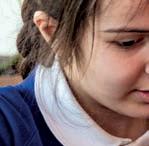
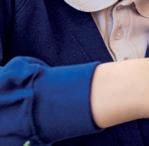





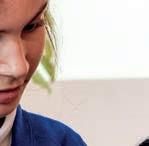






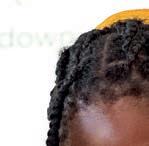

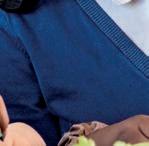




























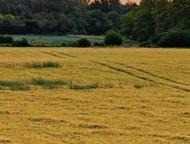



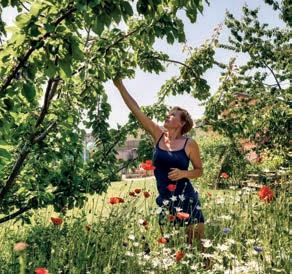

help to keep the pests in check (although there is a bug hotel for the overwintering good doers). There's even a beehive under expert management by local volunteers.
knows her stu ). There's no corner here wasted but still a feeling of space to roam. All the more surprising when you learn that this was once a rather wasted area of playground – rarely used due to frequent waterlogging, says Mandeville School Headteacher Marc Thompson.
As a growing zone, it's perfect. Shelter provided by the warm brick walls and ring of buildings beyond creates a microclimate perfect for wall-trained and freestanding fruit trees and bushes – choice rarities such as jostaberry and medlar among them. Tomatoes can climb and ripen on the vine in this sheltered spot, while salad comestibles and herbs enjoy optimal care in the raised beds, having been nurtured from seed in the highly productive greenhouse. Happy chickens roam and
Everything in this space is child-centric, including the raised beds at child height, and the process of growing from seed –taught in the Garden Room and garden itself – continues on to tasting at the table. Young children tend to be suspicious about anything unfamiliar put on their plate by adults, but give them the opportunity to savour the di erences between sweet, savoury and bitter by sampling a morsel from the garden then learning the name of the plant and they become more receptive. And if they've grown something from seed themselves or seen it flourish in the garden, children become way more inclined to give eating it a go.
Head Food Educator Tom Walker and team carry this adventurous growth mindset from the garden and Garden Room through to the School of Food. Here, the rituals of preparing and cooking something delicious together

and then sitting down as a group to feast nurtures positive attitudes to food, and social time around a table.
The hub this has become for the community beyond the school gates can be seen in the activities programme. From sushi and breadmaking sessions through to masterclasses in compost making, it all happens here. Hackney School of Food also welcomes private and corporate bookings –and what a great space for an away-day.
Children remain at the heart, and young people across Hackney and far beyond can enjoy a fruitful half or full day in the kitchen and garden. Cooking classes cover everything from basic nutrition and safe knife skills to eating with the seasons. In the garden and Garden Room, they find out how to grow and tend, discover more about pollination and insects, learn about soil composition and improvement and consider really big questions – food miles and reducing the environmental impact of what we consume included.
These are lessons that, hopefully, will shape positive lifelong habits. Mandeville and other schools within LEAP can testify to the di erence it makes to the children. "They have a better understanding of planting, food production and natural life cycles as a result of this rich experience. We see the di erence every day," says Marc Thompson.
Hackney School of Food came about thanks to support at local-council and London-wide level, and from generous charitable trusts. It has influential champions – Chefs in Schools and Sainsbury's among them. Bringing the idea from seed to fruition was a triumph. Let's hope it becomes a blueprint for other schemes, and for all that can be achieved when you create a space where children go on that journey from seed to fork – and enjoy the pleasure of food grown, cooked and eaten together.
hackneyschoolo ood.com

Andrew Copeman, Head of Lower Sixth at Latymer Upper School, on the silent crisis of boys leaving literature behind
The diminishing popularity of English has coincided with a dramatic surge of pupils taking Maths A level. This pattern is most noticeable among boys, who are gravitating more and more towards STEM subjects. On almost every educational metric girls outperform boys, with the exception of Maths and Science. Although positive in addressing boys’ underachievement, STEM success is increasingly coming at the expense of English.
At Latymer Upper School, the number of boys taking A-level English remains healthy, but in all-boys’ schools there has been a sharp fall in take-up of the subject. At a nearby single-sex school with a cohort of 215 Lower Sixth pupils, 201 boys take Maths, compared to just 13 studying English. The picture at another all-boys’ school in south London is even starker, where only three boys from a year group of 145 take English. This growing disconnect between boys and literature reflects a worrying national trend.
The reasons for this shift are numerous and certainly helped by successive governments’ focus on promoting STEM subjects in schools. University tuition fees and the economic climate have made pupils more transactional in their choices, often choosing subjects that lead to tangible financial rewards.
There has also been a cultural shift –teen icons are no longer anti-establishment figures but tech billionaires and ‘finance bros’. Studying a subject for pure interest and enjoyment, without obvious future riches, is seen as a luxury pursuit.
“English lessons are a natural space to challenge harmful attitudes”
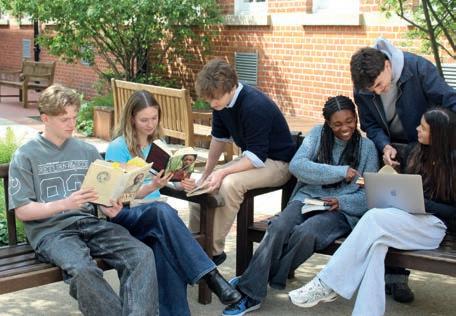
In a post-truth, fake news world, it is more important than ever that pupils are equipped with the ability to think critically, sift fact from fiction, challenge misleading narratives and communicate clearly. Usually developing more slowly than girls, boys are already in need of direction when it comes to addressing their own emotions. The study of English Literature, especially with the exploration of character motivations, attunes boys to nuances of behaviour, helping them to understand their own feelings and those of others.
This is especially important when considering malign online influencers, such as Andrew Tate, who spread messages of male superiority and female submission. Netflix’s drama, Adolescence, presented this very real danger but real-life examples of male aggression by school-age children are increasingly making the news agenda.
Four in five pupils in England study the AQA English GCSE qualification. Astonishingly, 75% of these teenagers are taught the text combination of A Christmas Carol, An Inspector Calls and the ‘Power and Conflict’ anthology. Only 2% of this large cohort explore texts by females and just 0.1% study texts by women of colour. This lack of diversity is one reason why
Latymer is reforming its Middle School curriculum. Carefully selecting rich and varied texts helps drive boys’ personal expression and self-awareness. It can promote healthy relations between men and women by exploring strong female characters and male brutality. English lessons are a natural space to challenge harmful attitudes – often resulting in better outcomes than scripted PSHE lessons.
Making English more interesting and appealing to boys won’t solve the problem of toxic masculinity but it will make a meaningful di erence. Making sense of literature helps alienated young men find connection and to feel a sense of belonging.
As C.S Lewis recognised: ‘we read to know we are not alone’.



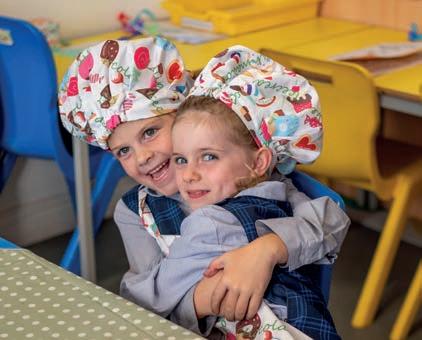








The Head of Digital Learning at Downe House on why an under-16 phone ban would help safeguard young people

Perhaps Australia has got it right?
The country’s recent decision to ban phones for under 16s feels, increasingly, like the right move. For years as a teacher, I have championed the idea that we should be supporting young people in managing their social media use – the idea being to educate rather than restrict.
Although I still believe in the power of education to create change for the better, I have more recently veered towards accepting that that it may not be enough to protect our young people. The algorithms are simply too powerful. If adults struggle to resist the pull of endless phone scrolling, what chance do teenagers have? In short, I believe that 16

and over is the right age to own a phone. By this point, our young people have had the chance to discover passions beyond the screen. They have likely begun to develop deeper focus and a growing engagement with books, ideas and culture. And they will have developed awareness that social media is often a curated façade. Most importantly, they have started to form a stronger sense of self – in terms of who they are, what they value and how they want to spend their time. That level of confidence, I believe, is the foundation teenagers need before stepping into the hyper-connected world of social media.
The media often resorts to clickbait tactics to drive tra c – relying on portrayals of the very worst of society and social media.The Netflix drama Adolescence managed to avoid this. Instead, it appears to have set out to raise awareness of the issues facing young people today. While its storyline may not reflect every teenager’s experience, the drama was rooted in actual cases from the UK, lending authenticity and emotional weight.
That said, in steering away from sensationalism, the show also largely overlooked the more positive aspects of social media. And we shouldn’t forget that they do exist. Social media can be a creative
“If fully grown adults struggle to resist the pull of endless phone scrolling, what chance do teenagers have?”
outlet – a place to connect with others, to learn, explore identity and find community. There is light in the digital world, too. Ultimately, the media often gets the dangers right, but the balance wrong. What is needed is a layered portrayal – one that acknowledges both the risksandthe agency of young people, and which invites adults to engage. To its credit, Adolescence prompted parents to pay attention. What it hasn’t quite achieved is an acknowledgement around the positive potential of social media. However, an important conversation has begun. What is needed now to realise that positive potential is a return to basic but essential tenets:education,wellbeing andcollaboration. Education, so that young people understand the digital world they are growing up in. Platforms could incorporate regular reflective prompts to help young people to manage social media pressure. Wellbeing, so that platforms are held accountable and focus ondesign for health, not just engagement, and with younger users’ perspective at the forefront. On that basis, developers should perhaps scrap the ‘like’ button, get rid of the endless scroll features, and remove algorithmic promotion of harmful content.

JANE BASNETT Director of Digital Learning Downe House School
























Wetherby Pembridge Minors Holland Park is an independent, co-educational nursery and pre-prep school for children aged 2 to 4.
www.wetherbypembridgeminors.co.uk



































































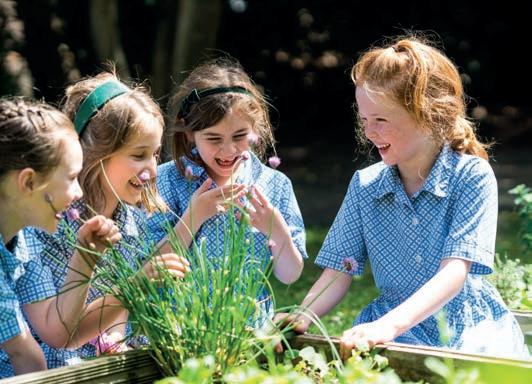
From
observing
the
seasons to growing and tending plants, outdoor crafts and creating wildlife habitats,
school
gardens
are a place for learning, contemplation and fun. We speak to three schools about how they manage garden time
Set within 23 acres of Su olk countryside, Framlingham College Prep School o ers its pupils plenty of freedom to play, explore and learn. The ‘hands, heart, head’ learning approach here recognises how children learn best. Connections are made first through their hands, via play and exploration. Then they make an emotional connection with their discoveries. After that, they use their heads to think creatively and critically. This approach enables children to explore independently and start to make links in their learning.
Throughout the academic year, the curriculum supports learning outside – no matter what subject or age group. From the Year 6 to 8 sessions learning camping skills and woodland crafts in Forest School to biology lessons at the College beehives for Year 4 and 5 pupils. Meanwhile, Early Years children begin their outdoor learning journey with insect counts and pond dipping. Framlingham College Prep believes that giving children the opportunity to appreciate nature helps them to
grow in confidence and independence and also develop a greater respect and understanding of the world around us.
The school’s Junior Duke programme – described as ‘rather like a mini DofE’ –o ers opportunities to develop di erent skills and nurture essential qualities. Skills learnt range from bushcraft and den building to gardening and mapping. Sustainability is a critical element and, since 2021, Framlingham Prep pupils have planted 420 trees across the school grounds in partnership with the Woodland Trust, also creating hedgerows to support habitats for native wildlife – these then become study zones.
The popular gardening club works to support insect and bee populations, and each year young gardeners take a selection of their green-fingered creations to the Su olk Show, last year winning Highly Commended in the school garden display class. The benefits of gardening and outdoor learning are critical for this age group, says the school, and range from improved motor skills to physical and mental health.
For some young children, outdoor learning can be daunting at first, but most pupils show
curiosity rather than fear. Being outside brings a feeling of freedom – to ask questions and speak openly without anxiety. Activities such as tending beehives or campfire lighting may bring some apprehension initially, but the school’s approach fosters open-mindedness and risk awareness while embedding valuable academic and life skills.
The school garden at St Chrisopher’s The Hall is a happy and tranquil space created by pupils themselves as part of a lunchtime gardening club and in celebration of the Beckenham, south London school’s 130th anniversary. It’s a small but much-loved corner of the school, nurtured by children who have taken real ownership of its upkeep. Over time, it has become not only a place of planting but a calm retreat where pupils go to sit and read, reflect or simply enjoy nature during class breaks. While the school has access to many beautiful outdoor spaces nearby for nature walks, play and exploration, the garden is unique as a space designed by and for the children learning here.
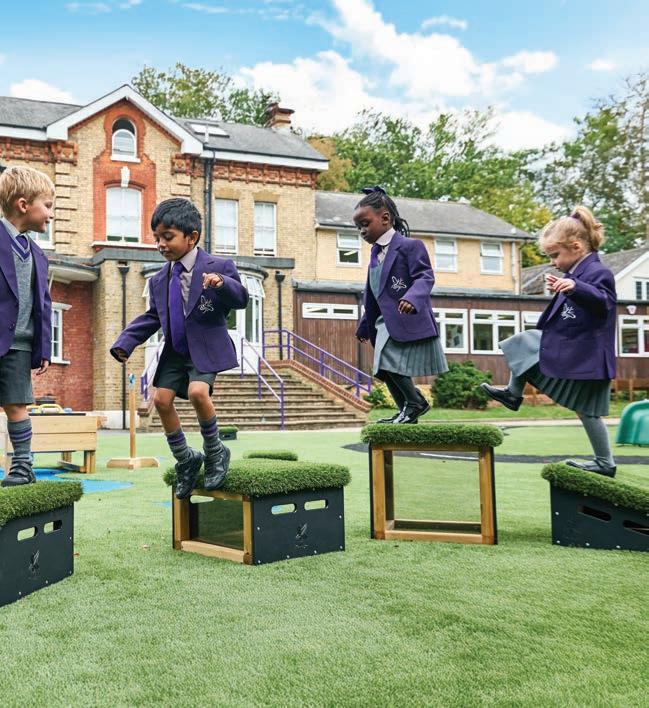
Welcoming girls and boys from Nursery to Year 1 in September 2025
St Christopher’s views outdoor time as o ering a valuable place to decompress, and the garden is especially valuable for pupils with SEN and those younger children who sometimes become overwhelmed in classroom settings. The sensory experiences of gardening – touching earth, smelling herbs, hearing birdsong – create a calming and grounded environment and pupils report that it helps them feel more focused and relaxed for the rest of the day.
The school’s most exciting recent project has been lavender planting across the garden. The children are learning how to care for and nurture the plants throughout the seasons, with the purpose of harvesting the lavender beds to create handmade lavender bags. These will then be sold at the school’s summer fair as part of an enterprise project, helping children learn about sustainability, small business skills and the full growing cycle from seedling to sale. It’s a practical, purposeful project that has sparked enormous enthusiasm.
Pupils are generally very positive about gardening – especially when they see real results, such as a flower they planted themselves start to bloom. For new gardeners, there may be initial reservations about worms and mud, but those vanish quickly once they get stuck in and start to have fun. The gardening club helps to model curiosity and resilience, and children support each other in overcoming initial hesitation or squeamishness.
St Christopher’s The Hall school garden has become a natural extension of the curriculum. From understanding plant biology and lifecycles in science to measurement and data collection in maths and storytelling inspired by nature for English, the outdoor setting provides
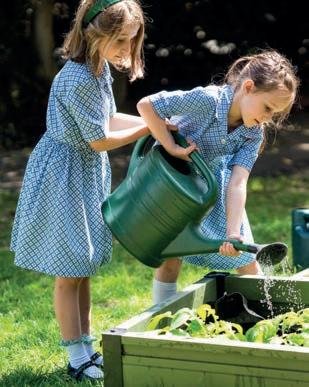
ABOVE
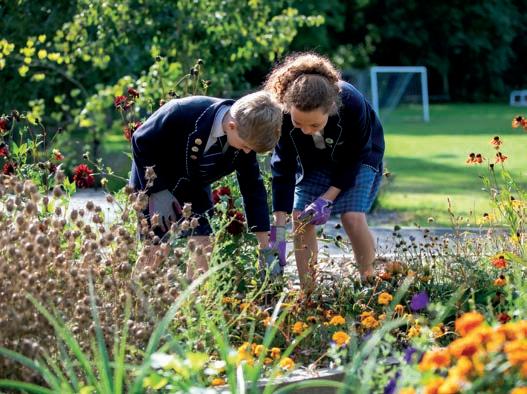
learning opportunities.
In particular, the lavender project ties into both science and enterprise learning, encouraging children to think critically about where things come from, how they grow, and the environmental impact of choices we make every day.
Set within 25 acres of green space in Cobham, Surrey, Feltonfleet has an expansive campus. This enables learning to spill naturally from classroom into the great outdoors.
Outdoor education is woven into the fabric of daily life. From sowing seeds in gardening club to harvesting vegetables in Forest School, pupils learn how to nurture plants and also care for themselves, each another and the world around. “The natural environment is a living classroom,” says Forest School teacher Anne Mossop. “It sparks creativity, builds resilience and cultivates a deep respect for nature.”
Weekly Forest School sessions take place for Pre-Prep pupils in all seasons. Pupils learn how to climb trees, cook over an open fire and develop craft skills. A recent Year 2 session saw pupils using the Japanese art of Hapa Zome, or leaf bashing, to create colourful mirrored prints. The conversations that followed about symmetry and colour change gave a snapshot of how outdoor learning helps to build core academic understanding.
Gardening club o ers a deeply sensory
experience. Pupils dig, plant, water, and wait. In doing so, they develop patience, responsibility and persistence. Feltonfleet finds that tending to plants encourages empathy and collaboration – and there’s the joy of tasting a tomato or strawberry they’ve helped grow at the end of it all.
All pupils benefit from daily access to outdoor space, with the majority of classrooms opening directly onto gardens and play areas. Regular engagement with the outdoors supports gross and fine motor skills development, nurtures confidence, and encourages independence. Whether it’s threading cereal hoops for bird feeders or creating homes for woodland creatures, younger pupils learn through purposeful play. For older pupils, outdoor time o ers valuable space to unwind and connect, be it in playing energetic ball games or tackling adventure play areas.
The wider school site is designed to provide outdoor variety, with quiet reading gardens, treehouse hideaways, wildlife ponds and woodland trails among the areas to be explored and enjoyed. This variety means every child can find their favourite spaces and spend valuable time there in activity or quiet reflection. In 2024, Feltonfleet’s ‘Roots for Tomorrow’ tree restoration project was launched to protect and regenerate the school’s green boundary, strengthen biodiversity, and deepen pupils’ environmental awareness. It reflects the school’s belief in sustainability and responsibility – not just for today’s learners, but for future generations.


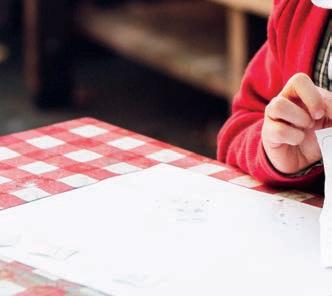


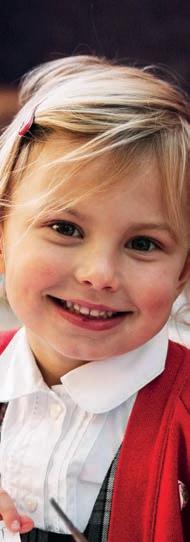
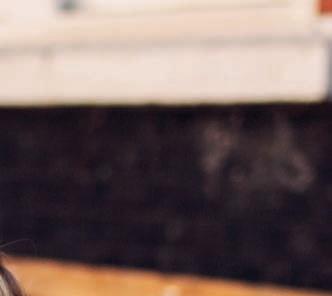


Chepstow House is a co-educational nursery and prep school for pupils aged 2 to 11, delivering a high standard of education in an enriching environment.
www.chepstowhouseschool.co.uk


Evgenia Lazareva, Founder of Phileas Fox Nursery in London’s Little Venice, on key areas to consider when choosing that first vital educational setting

ABOVE
Choosing a nursery for your child is an exciting first step in their educational journey, but it can feel overwhelming. A good nursery can work wonders for your child’s development, instilling fundamental skills for lifelong learning, so it’s important to allow plenty of time for research and visits to make the process smooth and rewarding. Here are practical tips to help with the choice.
Define your priorities Start by asking yourself why you want to send your child to nursery. Is it for childcare as you return to work, to prepare them for school or to give them socialisation opportunities? Understanding your primary motivations informs the type of setting you need. Some nurseries are open year-round and accept babies, while others admit children later and have strong ties to prep schools. You might prefer bilingual settings, Montessori or forest schools. It can be hard to find a nursery that ticks every box, but having clear priorities helps narrow your shortlist. Begin your search Start looking within your local community. Local parenting
groups – whether on social media or in person – are information goldmines. Many parents have navigated this exact process and are happy to share their experiences and recommendations. However, what works for one family might not work for another, so make your shortlist around your key preferences. Do keep an open mind, as you may find that a nursery you hadn’t initially considered becomes your top choice.
Arrange a visit If the essentials such as opening hours, holiday schedules and fees fall within your expectations, book a visit. No online reviews compare to seeing a nursery in action, meeting the leadership team and asking questions directly. During your visit, pay special attention to the sta and their interactions with the children. Also find out about qualifications and experience of the team and study the environment – is the space clean and well-organised with age-appropriate and stimulating resources available?
Look at the outdoor space, too, and ask to see where children nap. Finally, find out how the curriculum is delivered, how much individual attention each
“Ask yourself why you want to send your child to nursery – this informs the type of setting you need”
child receives and what regular planned activities take place. How is progress tracked and what measures does the nursery use to ensure school readiness?
Practical Elements come into play. Ideally, your nursery will be within walking distance from home or on your route to work. However, exceptional nurseries may be worth a longer commute if logistics allow. Consider session times and flexibility. It’s particularly important to know if the nursery will accommodate early drop-o s, late pick-ups and ad-hoc requests.
After each visit, listen to your gut feeling. You might know you’ve found ‘the one’ or have a few excellent options. Weigh up the pros and cons and arrange another visit if needed – particularly valuable if your initial visit was some time before your child’s proposed start date. The right nursery will nurture your child’s confidence, fostering play, growth and a love of learning. Taking time to choose ensures that first experience sets down a firm foundation for future learning success.









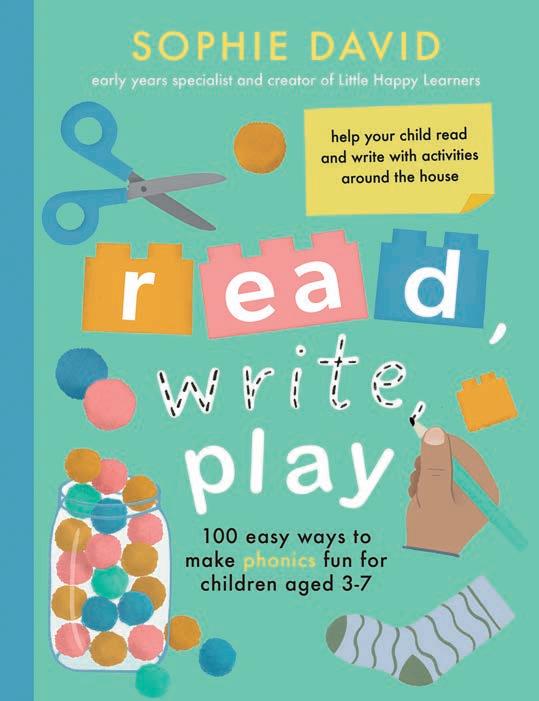
Early years specialist Sophie David is on a mission to demystify phonics with her latest book – and ensure children and parents have fun together

Mention
phonics to many parents and their eyes glaze over.
It’s something Sophie David saw as a teacher and specialist in early-years – the parent confused about what they actually were or worried about saying sounds wrong. It’s one reason she’s on a mission. “We need to change the narrative with learning to read and write,” she says. “Let’s try and embed as much play into our learning as possible.”
This is the approach that underpins Read, Write, Play – a comprehensive guide to phonics, but delivered in a way that’s accessible, practical and engaging for children and parents. It’s structured by age and phonics phase. The projects are simple, and come with excellent visual and written instructions – a lot of thought has gone in to creating such clarity. Ask how long she took to devise it and there are two answers. “The book has been in development for years, since I became a teacher! To write it has taken about a year.” It is a brilliant distillation of tested approaches – ones she’s used in her work and at home. In fact, the children in the photos are her young sons and daughter.
Read, Write, Play may have been created by a teacher, but it feels nothing like a school day. Usefully, it starts at beginning with Phase 1 phonics (age 2) and goes all the way up to Phase 6 (age 7). Phase 1 is all about games to support listening – the foundation of understanding how letters sound and being able to replicate them. By Phase 6, there are activities to help with reading practice, comprehension and spelling.
Originally, Sophie David’s publishers suggested the book should leave out Phase 1, but she argued the case. “Phase 1 phonics encompasses everything. It encompasses speaking and listening. It encompasses opportunities for sharing,
opportunities for really exploring sounds,” she says. “We need to start where that process begins for children.”
The other reason Sophie David wanted Phase 1 in is because not every child develops at the same rate. Always so, but right now it’s recognised that there’s increased incidence of speech and language delay. The jury’s out on why – a Covid after-e ect, screen time or multiple factors – but more children need some support. “I want every child to be able to access this, not just the neurotypical child,” she says. That’s also why there’s a set of images at the back, modelled by her daughter and showing the way our mouth should look when we make di erent sounds – extra expertise was provided here by a speech and language therapist.
While parents who would like guidance can dig deeper, the main body of the book delivers fun ways to help make phonics stick, so a great dip-in resource for those parents who just want some projects to try with their child. “One thing I wanted to get across is encompassing all parents, especially working parents. I just wanted to make the ideas

“If you’ve got a pack of plastic cups in your cupboard you can do at least 20 of the activities in the book”
accessible,” says Sophie David. “If you’ve got a pack of plastic cups in your cupboard you can do at least 20 of the activities in the book.”
The mix of ideas is varied to suit di erent timescales, ages and moods – and with lots of quick activities. Usefully, many of them, such as a treasure hunt in search of objects around the house, also burn o energy. “Sitting at desks and writing in a book is not the best way to learn, so I wanted to incorporate as much movement as possible.”
And, for the many parents who worry that their child is incapable of sitting still at all, Sophie David has welcome reassurance. “Typically, a child’s attention span is two minutes for every year of their life. So, if they are four, on average they should be able to concentrate for, say, six to eight minutes.” She’s keen to stress that this really does vary from child to child and also, importantly, children don’t just magically transform into beings who sit down and focus when you ask them to.
“Parents need to know that this attention span and the time that they’re giving their children, it doesn’t just start,” she says.
“What we have to start doing is building these little windows of fun and attention with games and listening activities so that it builds their attention span over time.”
Read, Write, Play is the perfect way to start building that attention span with activities that children will enjoy. Best of all, they won’t think of them as learning because they are interacting and playing with you.
Sophie David is a great fan of homebased play – she reckons it’s often more memorable for a child than an expensive day trip or carefully planned activity. “One thing your child wants is your time. The entire premise of what I do is trying to build these moments of connection.”
* Read, Write, Play by Sophie David is out now (Robinson, £22). For more of her play-based learning ideas, visit littlehappylearners.co.uk
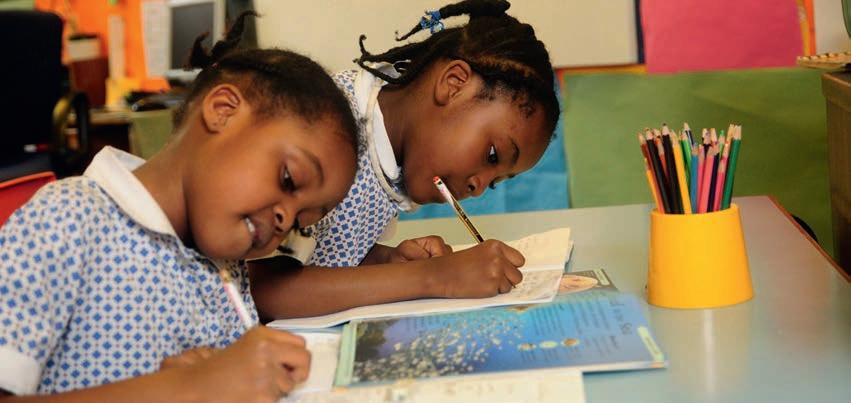
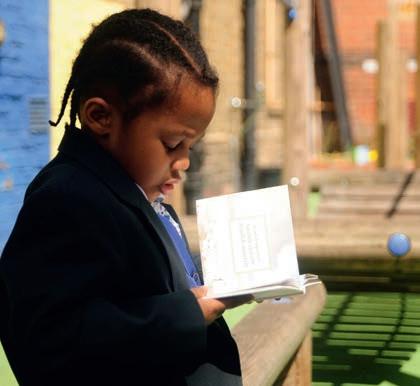
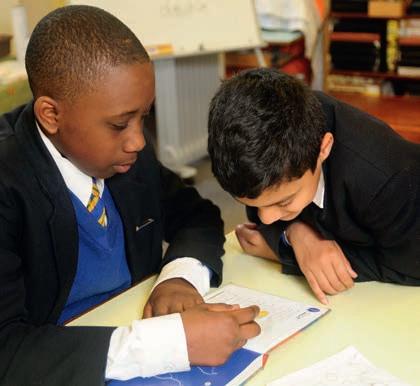
Tucked beside the vast green stretch of Tooting Common, Burlington House School’s South London campus is anything but typical. City schools often conjure up images of towering buildings, long corridors, and relentless noise, whereas Burlington House o ers an unexpected breath of fresh air – literally.
The campus is housed in a former 1920s family home. Its design and ethos intentionally retain that sense of warmth and familiarity. But what truly sets it apart is how the school embraces the outdoors, not just as a backdrop but as an active, integral part of how students learn and grow. For pupils with specific learning di erences, including dyslexia, dyspraxia and ADHD, the benefits of being outdoors are transformational.
The Burlington House curriculum is designed to meet the needs of students who think and learn di erently. Lessons are carefully structured into manageable segments, with regular opportunities to reset. Whether it’s a brisk walk to the school garden, a few star jumps in the playground or deep breathing under the trees of the Common, these short outdoor bursts help pupils regulate focus, reduce cognitive overload and return to the classroom ready to engage.
Outdoor learning isn’t an afterthought – it’s a strategy. Movement, sensory stimulation and natural light are used intentionally to support both academic
“Movement, sensory stimulation and natural light support academic outcomes and emotional regulation”

outcomes and emotional regulation. This is education rooted in understanding.
One of the most beloved features of the weekly timetable is the mindful walk. These slow, reflective journeys through Tooting Common are more than just gentle exercise, they are carefully curated moments of observation and connection. Students notice how the seasons change – the colour of leaves, the shape of a frost-covered branch, the scent of blossom on the breeze. Sometimes, the walk is paired with poetry and at other times, with simple breathing exercises. The result is a sense of calm, presence and groundedness – crucial ingredients for learning and wellbeing.
These experiences also o er a rare chance to step away from expectations and routines, helping students build confidence, character and a deeper connection to themselves and the world around them.
This quieter and more natural approach extends across the whole school culture at Burlington House. Where mainstream environments may be overwhelming – fluorescent lights, ringing bells, and constant noise – ours provides sensory-
friendly spaces, both indoors and out.
Students are also invited to shape their environment. The Student Council explores ideas such as building a vegetable patch, a greenhouse, a scented garden and even a bug hotel. It’s hands-on, creative and gives pupils a say in how their learning landscape evolves.
Embracing the outdoors means Burlington House works to create more than just a beautiful learning environment – it is nurturing future-ready learners. Students here are empowered to become confident in themselves, competent in their knowledge, creative in their thinking and strong in character. When education is designed di erently, young people don’t just succeed in learning, they thrive.

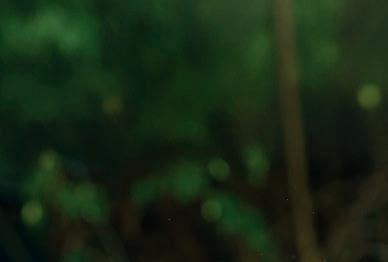

Pembridge Hall is an independent girls’ preparatory school providing an exceptional education that equips children for an ever-evolving world.
www.pembridgehall.co.uk
Challenging stereotypes among primary-age children is crucial in fostering an inclusive environment that promotes diversity and respect. By addressing and dismantling past stereotypes, educators help children to recognise the value of di erences in gender, race, ability and other characteristics. This helps to prevent the formation of biases that lead on to discrimination and exclusion.
At York House we use ‘Think Equal’ in our pre-prep, a programme that delivers social and emotional learning and challenges a discriminatory mindset. Curriculum design and resources are inclusive across the school – for instance, with books, stories, and resources that show diverse roles across genders. When having conversations with younger children, using gender-neutral terms – such as lunch sta – is helpful, too.
There should always be zero tolerance on misogyny, and coaching teachers to ensure they model non-stereotypical attitudes themselves helps avoid these in the classroom. In PSHE, our pupils are exposed to di erent careers, roles and responsibilities and these are regularly discussed from a gender viewpoint. As PSHE is a spiral curriculum, the issue of careers, roles and responsibilities is revisited each year in greater depth.
Role play activities are an excellent way of dispelling stereotypes. Allowing children to try out di erent professional roles in a
“Early intervention encourages critical thinking, enabling children to appreciate diverse perspectives”

classroom performance or during drama sessions, can be particularly impactful. ‘See Think Wonder’ activities – where images are presented of people who would traditionally be assumed to be a certain gender – supports this. Pupils describe what they see and develop an idea of what they think based on this first impression. Initial assumptions are then challenged by asking deeper questions.
Role modelling is key. Notably, boys and girls should have access to all sports. As educators we need to be instilling a culture where this is accepted as ‘normal’ despite traditional views on certain sports. By the same token, within the school setting, we can help to ensure a balance of genders in positions of responsibility across the sta and student community.
A visible diversity and inclusion team ensures the processes in school are always challenged – and it’s helpful to get pupils involved. We have launched a Kindness Council here at York House. Kindness Captains have been voted for and now
pupils meet to discuss how we can become more inclusive. We also try to emulate this when inviting external guest speakers into school, making sure we include professionals of di erent genders in a range of roles.
Early intervention encourages critical thinking, empathy and open-mindedness, enabling children to develop positive relationships with their peers and appreciate diverse perspectives. This not only enhances social cohesion within the classroom but also prepares children to navigate and contribute to a more equitable future.




MIKE
Head of Equality, Diversity & Inclusion

It may still have an image of village greens, fine teas and leather on willow, but cricket feels anything but sleepy for a new generation of boys and girls. Four schools tell us why it is such a brilliant school sport – and why it endures
Cricket may have a reputation as that most traditional of English sports, but there’s been a steady evolution – some would say revolution – in the game. New formats, the recent rise of girls’ and women’s cricket, plus the growing allure of the game across multiple continents. Its reappearance in the Olympics in 2028 in a T20 format (after a 128-year gap) will only add to its appeal and boost player numbers.
Grassroots starts young, and at Berkshire prep school Ludgrove there’s a sense of a whole landscape to discover as boys are introduced to the game. “It’s a culture,” says Gabriel French, Head of Drama/Performing Arts and also Head of Cricket. “Cricket is played through the year – it’s not just something that happens in the season.”
Ludgrove maintains a time-honoured tradition that all teaching sta get involved in coaching. “It does give us a di erent perspective of the boys,” says Gabriel French. “Very often you see a very di erent child, thriving in a very di erent way.”
Hailing from the Southern Hemisphere, he can well recall arriving at the school to see boys playing their version of cricket in the snow. “There is a wonderful game called stump that has been played since the school was started, pretty much,” he says. “As soon as they’ve grown out of a bat or a bat is broken the boys take it through to the woodwork store and the Head of DT, who is very much a woodworker, will cut o the sides and then they will use that in the morning game. It’s not unusual for a third of the school, 60 boys, to be down there in the morning playing stump.”
Ludgrove boys play cricket all year round, but anticipation rises palpably as summer approaches. “It’s such a big part of the school. You’ve got this big bank of nets and at break time nearly all of the school is out there playing. It’s just the most magical sight.” There are aspirations among many of the boys to be chosen to go on one of the school’s cricket tours – something to aim for. But for every level of ability and enthusiasm, there’s a sense of what Gabriel French describes as “pulling together”.
Children also love the whole ecosystem around the game – the history, rules, traditions. Gabriel French believes this plays
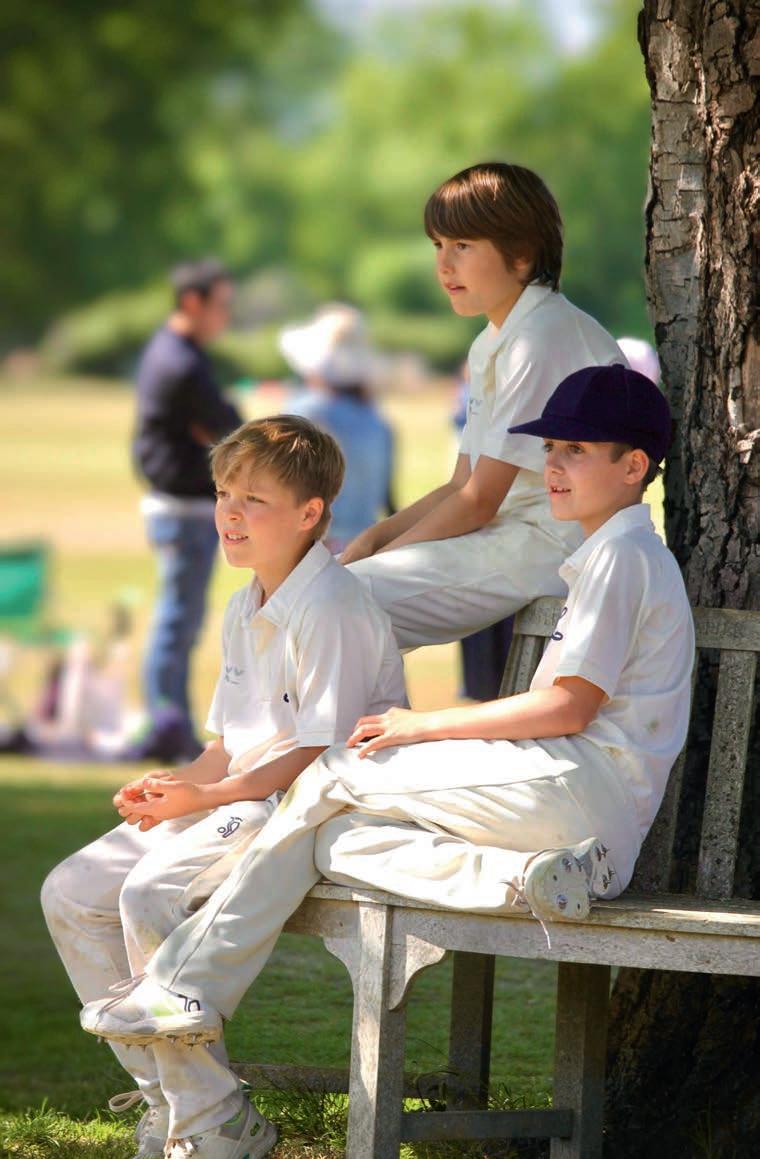
“At break time nearly all of the school is out there playing – It’s just the most magical sight”
a big part in its ability to draw children in. “Football is loved by so many because of its simplicity, whereas cricket seems to endure because of its complexity. Once you scratch the surface you just keep on finding areas of interest.”
Complexity certainly plays a part in the game’s allure, agrees Bedford School Director of Cricket Gary Steer, but he also thinks the respectful way it’s played counts. “It’s important, as well, that it’s played in a certain way. I think that’s even wider than just the game of cricket itself. There is a certain etiquette in cricket that can be spread in to other areas of life.”
At Bedford there’s a framework that supports players of every ability. “We have teams from Year 3 right up to the first team. Years 3 and 4 are soft ball cricket and hard balls are in use from Year 5 upwards. Each

year, we have at least four or five teams at each age group. Everybody who wants to play cricket will get a game of cricket.”
As a former player for Derbyshire CCC, Gary Steer is enthusiastic about the potential new formats bring to widen cricket’s appeal – it certainly drives enthusiasm among boys at Bedford. “They see it on TV and see the kind of shots that they want to play.”
The fact that this is the style of game that will be in the Olympics bodes well for those who love the format and want to take cricket further, but Gary Steer is also confident that the game o ers much more.
“Basically, you can go wherever you want to with it. Those who love it and are really good at it can go on and have a career. For those who love the game but aren’t quite good enough, there are other roles,” he says. “You can be involved with cricket as a player or in other areas – such as umpire or coaching – for a very long time.”
Bedford School is doing its bit to grow the game, and its partnership with Northamptonshire CCC supports upcoming talent and helps the next generation of cricketers to play of their best. Gary Steer thinks the game o ers something unique. “One thing that probably attracts a lot of people to the game is that there are a lot of skills involved,” he says. “Most boys – and girls – can probably find a role within the team.”
Reed’s is also helping to grow the game and Head of Cricket Chris Boyle is proud that the school typically fields 24 teams in the summer. That includes two girls’ teams made up of those who join the school at Sixth Form. “That’s only going to get stronger as we’ve got girls coming in who play cricket to a decent standard.” Lower down the school, students are supported in raising their game with oneto-one sessions with coaches – and any level of cricketer can book a session and work to improve technique.
That ability to strive as an individual to help the team is vital to the game’s popularity, but Chris Boyle says another great selling point is the social side. “The boys and girls are playing for local clubs, and they play against each other on a regular basis outside of school.” He thinks it’s important that cricket maintains its variety of formats, not least because each o ers di erent opportunities and suits di erent talents. “The shorter the format the less the opportunity for players to


contribute. Generally, not so many people bat if you are playing 20 overs, so I think a mix of format is a good thing.”
Certainly, at Reed’s the longer competitive games, played on the school’s ‘Big Side’, are a huge draw for the school and a lot of pupils will come out to watch the action unfold between lessons. There’s a real pride in being part of a team that plays on this hallowed space. “It holds a lot of value within the school,” says Chris Boyle.
“There is a certain etiquette in cricket that can be spread into other areas of life”
Another highly valuable asset in fuelling interest in the game is data, with easily accessible stats on who’s playing and how they are doing. “You can be with an A team and they know who scored runs in a C team while the game is going on.”
Ultimately, cricket is a great survivor because it continues long after school, says Chris Boyle. “You can find your level and keep going for a long time,” he adds. “Children can play with their parents in a team and maybe in 20 or 30 years they will be doing the same with their children.”
Michael Powell, Director of Cricket at Rugby School, sees another really engaging element in cricket happening now. “If we talk about the traditions and history, this is what is really exciting about the girls’ game now. Of course, the boys’ and men’s game is steeped


in probably 200 years of traditions. But you’ve got girls coming into the school now from really competitive families. They’ve got parents and grandparents who have played the game and you can see cricket is part of their family life.”
As a former Warwickshire CCC Captain, Michael Powell also knows the power of heroes to engage younger players.
“Selfishly, from Rugby School’s point of view, it really helps having someone like Maia Bouchier as a former student of the school. She’s just outside the England team at the moment but she’s performing brilliantly for Hampshire,” he says.
“We’ve got that in the boys’ game with Jacob Bethell, so having two England internationals that were in the school in the last five years makes a massive di erence.”
“Cricket combines the drama, the flair, the patience – I've always felt it mirrors life”
If future pathways matter, so do the foundations – one great benefit of cricket’s increasing visibility is having an influence on primary and junior sport. “You don’t have to go back too far and all prep and primary schools were playing rounders –now they are playing cricket.”
The rise of girls’ cricket is great news, but Michael Powell believes it remains a harder path at the moment. “If you took a very talented under 13 boy and a very talented under 13 girl joining

the school, the pathway for the girl to get to the top is probably higher than it is as a young male cricketer. But that in itself is fast evolving. There are more and more girls playing the game, which will drive competition, and competitive opportunities.”
Of course, for the vast majority of students, the game is there to be played for enjoyment, and for the team, and that ensures its broad appeal. “The lifeblood of the game is the new generation coming through now,” says Michael Powell.
“Obviously, it’s your Jacobs and your Maias that are in the spotlight, but I think the most pleasing thing for me personally as a Director of Cricket is how many boys and now girls come back to the school and play for our Old Boys’ side and soon to be Old Girls’ side. And they are involved in cricket – be it at university, at a club or for charity.”
Ask why cricket keeps evolving and why it endures and Michael Powell has a good answer. “The kids look forward to the game and then they reflect on the game gone. There will be highs, there will be lows, just as there are in a family,” he says.
“I think it’s the variety involved in the game – the chance for you to shine, the chance for you to show your skill within a team environment. Cricket combines the drama, the flair, the patience – I’ve always felt it mirrors life.”

etherby enior chool in central ondon is an independent day school or boys aged to , o ering an outstanding education that prepares pupils to stand out on the global stage. With excellent pastoral care and a strong record of acceptance to top universities, the school guides each student towards a bright future.
www.wetherbysenior.co.uk
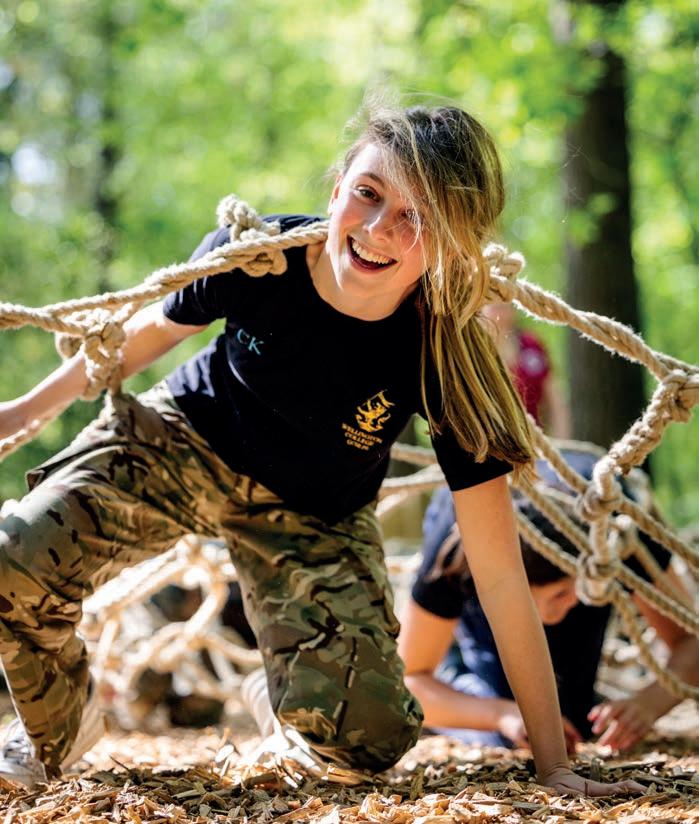
CHALLENGE ACCEPTED
66

Extracurricular elements of school life – including CCF and DofE –o er adventure but also deliver skills and qualities that are invaluable for future life and career. We ask three schools how they develop young people through a culture of service
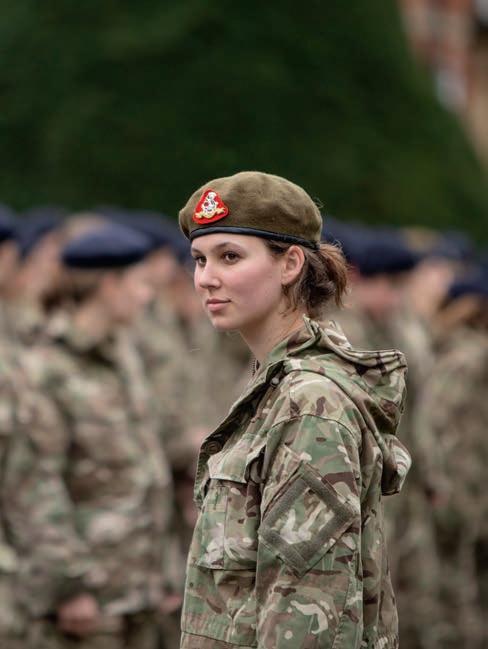
At Malvern College, service is not simply an extracurricular o ering but a defining element of the educational ethos. As a full boarding school and home-away-from-home for pupils aged 13 to 18, the Worcestershire school works to create a supportive environment where young people can explore, commit to, and grow through service at a pivotal stage in their development. The diverse community includes pupils from around the world – many are from services families – and this global perspective enriches community engagement and adds depth and resonance to programmes.
From the moment they reach Remove (Year 10), every Malvern pupil participates in either the Duke of Edinburgh’s Award (DofE) or the Combined Cadet Force (CCF), with many choosing both to get a breadth of challenges and experiences. The DofE programme, led by Head of Outdoor Pursuits Jay Watts, includes both Silver and Gold awards and o ers opportunities for physical challenge, community volunteering and expedition-based learning.
The CCF at Malvern provides a structured, skills-based environment
encompassing the Army, RAF and Royal Marines sections. This programme supports character development through leadership tasks, outdoor training and teamwork. And it’s exciting, too: recent introductions include flight simulator technology for RAF cadets, laser rifle training on the neighbouring Nine Acres grounds and a Bronze Award at the 2025 Cambrian Patrol. For two consecutive years, a Malvern CCF pupil has also held the prestigious title of Lord Lieutenant of Worcestershire’s cadet.
Malvern College says these experiences o er lasting value. Pupils build confidence, develop initiative and learn to lead and support one another – qualities that serve them well in further education and future careers and help them stand out from other applicants. Parents frequently speak to the transformative impact of these service opportunities, recognising their role in shaping mature, capable young adults.
Beyond DofE and CCF, Malvern’s broader culture of service is embedded in weekly routines. Each Wednesday afternoon is dedicated to partnerships and volunteering, all of which are entirely pupil led. College pupils assist in local schools, lead digital safety initiatives and take music and performance into care homes. They
also engage in longstanding international partnerships, such as the OSCAR Foundation in Mumbai and sustainable farming initiatives in Peru.
Charity work is a vibrant part of house life, with fundraising events supporting causes ranging from Cancer Research UK and Mind to the local Malvern Hills Foodbank. These elements of service and giving back often stem from personal connections. Recognising the scope of this work, the school is currently appointing a Head of Community Partnerships and Service to coordinate and further develop opportunities.
At Wellington, hands-on service is central to its Global Citizenship character development programme. Every Wednesday afternoon, all students take part in community-based activities – from CCF and DofE to supporting the work of care homes. These projects are led by a dedicated team of specialist teachers and embedded into the timetable.
Every Fourth Form pupil participates in CCF via weekly activities centred around the Salamanca Shield, an interhouse competition based on military and adventurous training skills and culminating in a five-day training camp. Many Fifth and Sixth Form pupils then continue on with CCF. Large numbers also participate in DofE – right up to Gold in the Lower Sixth. This year, 196 students are taking DofE Bronze in Third Form, 24 are doing Silver in Fourth Form and 18 are completing Gold in Lower Sixth.
“Our inbuilt service culture develops empathy, leadership and a sense of global responsibility,” says Head of Global Citizenship and CAS Coordinator Rebecca Parks. “Many alumni go on to take up volunteering roles as a result of their experiences.” Wellington is mindful of University of Northampton research indicating the significant positive impact of CCF on young people – both in improving school performance and in boosting future career prospects.
“ We listen to pupil voices and empower them to take action on causes close to their hearts”
Wellington’s history – it was founded as a school for the orphaned sons of army o cers – means the spirit of service is embedded in its culture. Both parents and the school see huge value in helping young people to build strengths through service. Community initiatives and service leadership roles also provide an opportunity to build networking skills, uncover interests and skills and get a taste of di erent roles and types of work. Students regularly draw on these real-world experiences when applying for work experience, university places and first jobs. Being active through service also develops crucial transferable skills – including resilience, adaptability, leadership and communicating with people from di erent backgrounds.
The school’s long-running partnership with local LAN special needs school Carwarden House has built both friendships and a vibrant activities programme, with pupils fundraising to deliver treats such as a Thorpe Park trip. Many such community initiatives are pupil led. For instance, there was a recent toy drive to support Afghan refugees. “We listen to pupil voices and empower them to take action on causes close to their hearts,” says Rebecca Parks. “This includes the Cerebral Palsy Trust, which was established by pupil David Loftus and his school peers. Pupil members recently organised a Christmas Inspire Day to celebrate the enormous progress they have made.”
Wellington’s Peace and Conflict Institute supports the charity Care4Calais and 27 pupils recently travelled to France to spend two days supporting their work in refugee camps. Other initiatives include pupils and sta teaching Latin to students at nearby Edgebarrow School, and outdoor activity sessions for local primary school children.
At Oakham School, service is embedded into the school calendar, with extracurricular activities included as part of the weekly timetable, plus weekends of activity, residentials and expeditions. With these regular opportunities beyond the academic sphere, Oakham aims to deliver the holistic education that prepares pupils for life beyond school. “Our service options of DofE, CCF, and Voluntary Action cultivate not just well-rounded students, but compassionate and capable young people prepared to serve and lead in a complex world,” says Oakham Director of Adventure, Matty Powell, The Rutland school’s Connected Curriculum weaves together academic,

“These moments of challenge help our pupils grow personally and face obstacles with greater confidence”
pastoral and co-curricular experiences, with pupils actively encouraged to develop five essential life skills – Communication, Social, Self-management, Research, and Thinking. Service options o er the perfect place to develop all five. A team supports Matty Powell in delivering the service and adventurous learning programme, with qualified coordinators across DofE, CCF and VA, plus a specialist Adventurous Learning Co-ordinator.
Pupils in Years 7 and 8 are introduced early to the values and benefits of service and adventure through charity initiatives such as the Harvest Challenge, bake sales, charity bike ride and annual adventure camps. In Year 9, all pupils have a formal introduction to CCF, DofE and VA via a carousel of activities and experiences across the three terms. At the end of the year, they also experience an expedition, which they can count as their Bronze DofE Expedition.
From Year 10, pupils can choose whether to progress through the Silver and Gold Awards – with canoeing, cycling, and sailing, in addition to walking. They also have the flexibility to continue with CCF and VA by choosing all three service options during their weekly Activities sessions. This flexible pathway continues in Year 12. Even if pupils have never done DofE at Silver or Bronze levels, they can choose to complete their Gold DofE during this year, with an option to complete a CCF-organised expedition to Norway.
At each stage of the DofE awards journey, pupils are mentored by trained sta and older pupils who develop their leadership skills through its Young Leaders programme. CCF is an equally popular
option from Year 10 onwards, with pupils participating in its programme of training and adventure via real-world challenges and unforgettable experiences – from fieldcraft exercises to annual camps.
Voluntary Action has seen a big growth in popularity, with pupils participating in an invigorated programme of volunteering. “We lead initiatives that nurture a culture of service, teamwork and emotional intelligence. Our projects range from intergenerational storytelling with dementia patients to sustainability e orts like uniform recycling,” says Head of Voluntary Action Monica Fernandez.
The Oakham School Foundation Project adds an entrepreneurial edge to service culture. Every Sixth Former is challenged to pitch, fundraise, and deliver projects that make a tangible di erence to school life, working in connection with the Development O ce. From installing solar lighting and restoring the local canal path to creating a time capsule legacy, the winning teams develop enterprise, collaboration and leadership skills to enrich school life and leave a legacy.
Oakham sees the encouragement of service activities as bringing a wide range of benefits. “These moments of challenge help our pupils grow personally and face obstacles with greater confidence,” says Matty Powell. “Leadership opportunities also play a crucial role in strengthening communication skills and self-assurance.” Parent feedback on the many service elements of school life is overwhelmingly positive, he adds. “Parents frequently highlight the character-building aspects of these programmes, especially their impact on resilience, leadership and responsibility.”


Alex Foreman, Principal of DOYRMS, on the importance of a strong co-curricular culture in helping students to develop strengths

When parents ask me what makes a great school, my answer is simple: it’s not just about academic results – although those are, of course, important – but the breadth of opportunity that surrounds a child’s education. In a world that is fastchanging and fiercely competitive, the best schools are those that develop the whole child – academically, socially, emotionally and practically. And that only happens when students are exposed to a wide variety of
“Young people need to work as part of a team. They need to experience leadership, fail safely, learn quickly and bounce back stronger”
experiences that build character, resilience, curiosity and creativity.
At The Duke of York’s Royal Military School (DOYRMS), we o er a culture of possibility. Students don’t simply follow a curriculum but lead teams, produce theatre shows, compete at national-level sports, take part in debating, coding, music and Duke of Edinburgh’s Award expeditions. These experiences shape them as much, if not more, than any classroom lesson. We believe access to enrichment should never depend on a family’s ability to pay for add-ons. It’s a principle rooted in our history and lived through our values of equality of opportunity, personal growth and high aspiration.
Why does this matter? Because young people today need more than qualifications. They need confidence. They need to work as part of a team. They need to experience leadership, fail safely, learn quickly and bounce back stronger. These are not

abstract qualities – they are teachable and can be developed through co-curricular life.
Whether it’s navigating a climbing wall, performing to a packed theatre, building a robot or leading a cadet parade, such moments create real, transferable skills. They help students to understand who they are and what they are capable of. Indeed, it is often in these spaces – away from classroom learning and exam pressure – that young people find their voice and their path.
Of course, strong academic outcomes remain a core part of any school’s o er.
At DOYRMS, we are proud to be in the top 5% of schools nationally for student progress at GCSE. Our A-level students consistently achieve outstanding results, with 95% progressing to university, 40% of these being Oxbridge or Russell Group. But academic outcomes are strengthened, not overshadowed, by wider opportunities.

As educators, it is our job not only to teach but also to empower. We work to ensure every student leaves us with the grades, sense of purpose and skills to thrive in life. That’s why I would urge parents to look beyond league tables and ask a deeper question: ‘What kind of person will my child become here?’. School is more than a place of learning, it is a launchpad. The more opportunities it provides, the higher a child will soar.




Nick Drane, Head Golf Coach at Loretto in Edinburgh, on its commitment to helping young players to achieve their full potential through golf
Rory McIlroy’s recent triumph at the Masters was so much more than a sporting milestone – it was a masterclass in perseverance and determination. His victory serves as a powerful reminder that, in golf, there’s no such thing as a perfect game. Success lies in the ability to maintain focus and composure, adapt to setbacks, and to demonstrate the resilience to keep moving forward.
Golf is more than just a game – it’s a teacher. It sharpens focus, instils patience, and fosters mental toughness. Beyond these invaluable life skills, the sport o ers countless benefits. Time spent outdoors improves overall mood and lifts the spirit, while its physical demands enhance coordination, strength and endurance. It’s unsurprising that schools across the country have started to include golf within their educational and extracurricular o erings.
Loretto’s Golf Academy has been at the forefront of this movement. Established in 2002 as the first of its kind within an independent school, it continues to set the standard for excellence in golf education. The game – and the qualities that it inspires – aligns with the school’s wider commitment to developing young people in mind, body, and spirit.
Today, Loretto Golf Academy welcomes golfers of all levels, from enthusiastic beginners to aspiring professionals. Three distinct training programmes – Club, Team and Reds – ensure that every pupil receives tailored coaching from five highly experienced PGA professionals. With access to top-class facilities and match play opportunities on some of the world’s finest courses, including on Scotland’s Golf Coast, each pupil is empowered to compete and realise their potential. Of course, it’s not all play. Pupils balance their time in the Golf Academy and at tournaments with their studies, extracurricular activities and additional responsibilities – mind, body and spirit in action.
As the home of golf, it’s essential that a love for the game is preserved, so that it can continue to be enjoyed across generations.

“Golf is more than just a game – it’s a teacher. It sharpens focus, instils patience, and fosters mental toughness”
changing this – inspiring girls to embrace the game, challenge themselves, and seize every opportunity to achieve their potential. One third of our Golf Academy members are female – a statistic we are proud of and determined to continue growing.
For its legacy to carry on, fostering a love for the sport from a young age is key. Many golf clubs have initiatives in place, encouraging children to take up the game. Loretto presents a unique o ering, being the only independent school in the country to host its own World Amateur Golf Ranking (WAGR) tournament – the Loretto Junior Golf Tour – which is open to all aspiring junior golfers, not just those at the school. Additionally, scholarships are available for those looking to combine an exceptional education with their golfing prowess.
Historically, golf has been perceived as a male-dominated sport, leaving women underrepresented. Loretto is committed to
Over the years, countless Lorettonians have gone on to achieve great success, testament to the talent that is nurtured here. Whether they go on to professional careers, secure college scholarships or continue to play for pleasure, their individual journeys reflect the impact of including golf as part of a holistic education. More than just a sport, golf fosters focus, resilience, and a love for physical activity – helping to shape well-rounded, confident young people.















The
CCF
Commander at
St
Albans School on the wide-ranging benefits for young people of Combined Cadet Force participation
Combined Cadet Force (CCF) is gaining in popularity with students today due to its emphasis on personal development.
The tri-service (Army, Royal Navy and Royal Air Force) cadet force which exists in schools adopts a military theme in a structured environment to provide opportunities for problem-solving, adventure training, selfdiscipline and community service.
Essentially, CCF experience encourages young people to take responsibility for themselves as they grow in confidence and build social connections. Young people will also develop key leadership skills as they take on various challenges and move through the rank structure, all while taking greater accountability for others around them.
As we become more locked into technology, CCF o ers students an opportunity to get outdoors and physically interact with their peers through the activities o ered within the CCF syllabus. It gives young people the chance to tackle activities and challenges they otherwise wouldn’t have participated in. How many students get the chance to experience the thrill of flying planes or gliding, go on overseas expeditions or fire live ammunition as part of their education? More importantly, it provides a level playing field at the beginning of the journey. As such, it reaches out to and develops even the quietest or shyest of students.
Developing confidence, resilience, determination and self-e cacy is a huge part of engaging in CCF training, but the
“CCF encourages young people to take responsibility for themselves as they grow in confidence”

softer life skills are equally valid. Even participating in the dreaded ‘drill’ teaches collaboration and teamwork, evoking an immense feeling of satisfaction when a tricky sequence or parade is completed.
There are many practical skills learnt, and these also have wider value. Students undertake basic first aid and fieldcraft. Marksmanship teaches transferable lessons in concentration, focus and self-discipline. Alongside skills of navigation, students also have the opportunity to develop their music and vocational qualifications.
CCF values lean heavily on those of the armed services and this in turn reinforces schools’ values. The University of Northampton recently completed a study on the impact and value of CCF and reported that cadets have lower levels of absenteeism and exhibit more responsible attitudes and supportive behaviours. This leads them on to positive relationships with sta and peers. The report noted that structured activities help promote mental health and wellbeing, preparing young people to deal with future life challenges. At St Albans, we are fortunate to have a network of alumni who are currently serving in the armed forces and pass on the benefit and wisdom of their
knowledge and experiences to the younger cadets through inspiring visits.
Every young person should have the opportunity to engage with Cadet Forces. For parents, it is excellent value for money and it provides a unique opportunity for young people to engage with role models and receive peer mentoring. CCF training influences career aspirations and ambitions, challenging and pushing young people out of their comfort zone. Without challenge there is no personal growth, and so learning to navigate life’s hurdles through programmes such as CCF can only be a positive step for young men and women.

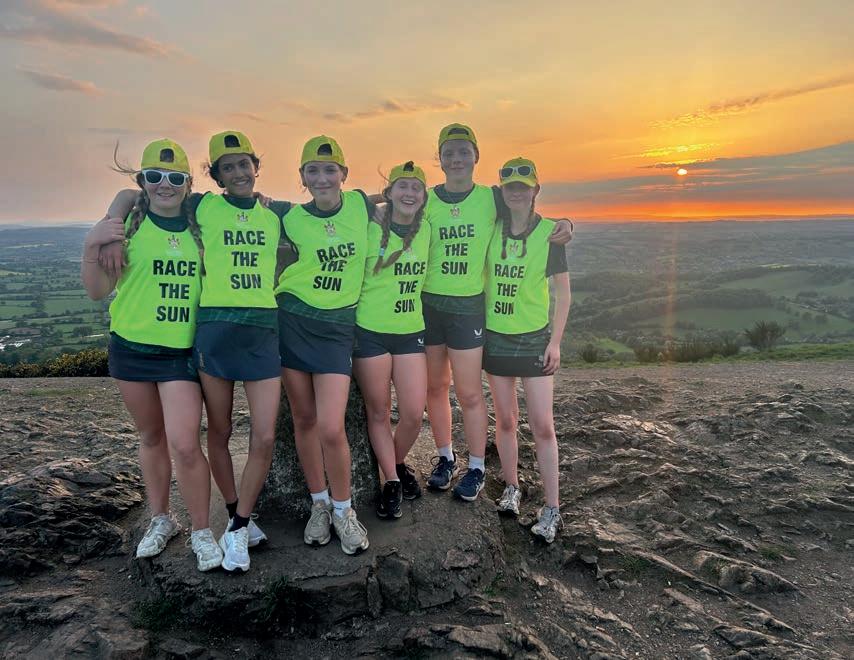
The Headmaster of St David’s College in North Wales on the true value and purpose of a scholarship programme
What is the purpose of a scholarship?
Many may question the motivation behind scholarships o ered by private education providers and universities, with cynics concluding that they do little more than provide a mechanism for a deal-closing discount. It’s true that scholarship schemes may indeed positively tip the balance of a ordability for some families, but there is more value to a scholarship than can be recorded on an accountant’s spreadsheet.
These days, scholarships do not need to be aimed solely at the academically elite. They can be a reward for more holistic e orts and achievements by individuals.
At St David’s College in Llandudno, we have just launched our 60th Anniversary Excellence Scholarships, which will provide 60 scholarship opportunities over a five-
“Scholarships are meant to celebrate and reward the extraordinary, and it’s imperative to recognise that excellence takes many forms”
year period. Yes, they include academic accomplishment, but additionally are in recognition of sporting achievement, leadership in outdoor education and overcoming barriers to learning, among other categories.
Scholarships are meant to celebrate and reward the extraordinary, and it’s imperative to recognise that excellence takes many forms. It is seen in the pupil who works hard to achieve academically when faced with the challenge of dyslexia.
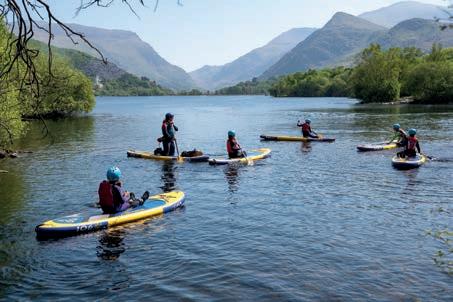
Excellence is also seen in the pupil who is the first to volunteer for extracurricular activities and, as a result, galvanises the pupil community. We also see it in the footballing sensation who puts in so many hours of dedicated practice to hone their fitness and skills and compete at the highest level.
St David’s College has long recognised these extraordinary traits in our pupils, which is why we have remained a nonselective school that o ers mainstream education alongside an exceptional range of activities essential to the pursuit of a whole-person education – award-winning outdoor activities, sport, performing arts, music, design & technology among them. The school embraces pupils with barriers to learning such as dyslexia and dyscalculia, and we provide expert support to ensure young people are taught in a way that best suits their style of learning.
At the heart of this ethos lies outdoor education and sport. Whether it’s


heading o into the mountains for orienteering, battling the high seas in a kayak or braving the elements to do battle on the rugby pitch, pupils return from these activities buoyed with the confidence and joie de vivre which few other pursuits could instil in them. They have often achieved something that they feared they could not – standing up on a paddleboard, steering a powerboat safely onto its mooring, facing an opposing team on the sports pitch – and then emerged stronger on the other side, discovering along the way the natural euphoria that physical activity engenders.


These are achievements that both support and transcend the academic. When schools can use scholarships to both reward individuals for their own achievements and strengthen and invigorate a school community that values these traits, then – to return to the original question – the purpose of a scholarship does not lie in the measurable, but in the immeasurable.



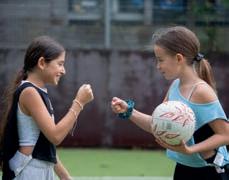






King Alfred is an informal, co-educational day school in Hampstead for students from Reception to Sixth Form which focusses on academic & personal success through its innovative curriculum & child centred approach.
The
Director of Sport at St George's Ascot on its enhanced swimming programme and increased provision in traditionally 'male' games
Swimming is one of the most demanding sports a young person can pursue. It requires precision, power, time management and grit. That’s why, this year, we’ve taken our swimming provision to the next level.
Our Performance Swimming Programme o ers talented young swimmers a highperformance coaching environment while ensuring they continue to thrive in the classroom. This September we will welcome the first group of girls onto our elite swim programme with training sessions integrated into the school day and throughout the week, enabling the girls to strike a good balance between academic focus and athletic ambition
I am excited to welcome Nicky Matthews as Head Coach for our Performance Swimming Programme. Nicky has extensive experience developing young swimmers to a national level – her approach is purposeful and professional, but also incredibly supportive. She coaches with drive, challenging and championing young athletes to take their next steps with confidence.
In parallel with our swimming development, we’ve also expanded opportunities in cricket and football, giving girls a chance to explore sports they may not have considered their own. Cricket is now a key part of our summer and winter calendars, following the installation of our indoor hardball cricket nets last May. We are
“A favourite part of my job is seeing a girl realise what she is capable of – these are the moments that build character, not just athleticism”

supported by a coaching partnership with Royal Ascot Cricket Club.
Our girls are thriving in matches, developing technical skills, tactical understanding and loving the camaraderie that cricket brings. We have embedded specialist coaching, competitive fixtures and a pathway for those who want to pursue the game seriously. The same is true for football, which has seen a sharp rise in interest and talent. With growing national visibility in the women’s game, it felt essential to give St George’s girls the chance to be part of that movement.
While our Performance Swimming Programme, football and cricket may be the latest additions to feature in our rich and diverse sports programme, we are continually evolving our provision to ensure every girl finds her space to shine. From netball to tennis, dance to badminton, athletics and beyond, our girls have the chance to enjoy, lead and inspire.
A favourite part of my job is seeing a girl realise what she is capable of. Sometimes that moment happens in a fixture, sometimes it’s in a training session, sometimes it’s just the quiet pride of
knowing she kept going when something felt hard. These are the moments that build character, not just athleticism.
I have experienced time and time again that when girls are given the opportunity to lead, to fail safely and try again, they discover they are capable of more than they ever imagined – and that is what sport in schools should be about. I want every girl to leave us knowing they can stay in sport in whatever form they choose, whether that is through competition, coaching, volunteering or simply for personal enjoyment.
I am so proud to be part of a school that is investing in the future, and doing so with purpose.



Back in the day, physical education was about 'building character' –usually some combination of running, endurance and inclement weather. Thankfully, these days, we have a much better understanding of how physical wellbeing can support general wellbeing. This is one of the reasons schools are considering more outdoor enrichment.
LPS Mayfair has no shortage of exciting activities on its doorstep, but there is a shortage of readily available outdoor activities in the immediate vicinity. This contextual problem is a daily reality for our student population, many of whom are very active, but work hard to seek out opportunities for sport and recreation. So, when I was asked to lead a weekly enrichment activity, a colleague and I had a brainwave. As keen cyclists ourselves, we headed straight to the Stratford VeloPark, originally built for the 2012 Olympics and

“Sharing the learning journey with students makes an activity all the more meaningful”

still o ering world-class sporting provision. Many parents and schools may see the red flags already – cycling is a high-risk activity; the venue is ten miles away by public transport; the pool of keen and available students is relatively small.
All of these issues required initial e ort to mitigate, but we knew the power of VeloPark, and we wanted to promote our sport, its social and personal aspects and its relevance to ecology and urbanism. Best of all for enrichment variety, the VeloPark o ers four di erent disciplines of cycling on safe, separated courses. There's road, BMX and mountain biking plus, of course, track cycling on the indoor velodrome itself.
Between us, having (touch wood) completed almost three years of this activity without a serious issue, my colleague and I suggest the following for any school planning something new, fun and stimulating for an extracurricular o ering.
First, choose an activity you personally enjoy and can enjoy personal development in, too (not something you're already expert in). Sharing the learning journey with students makes the activity all the more meaningful. It goes without saying you need
all risk assessment paperwork and parental communications in place.
Make it self-sustaining and portable. If you can substitute sta at an hour’s notice, that’s the gold standard of a successful enrichment activity. Then publicise, advertise and promote. Get as much momentum behind it as possible, as enthusiasm will spread and you will all get to keep doing something you enjoy.
Refine and perfect the enrichment activity until it is providing just as much mental boost to you as your students. I’ll never forget a Tuesday afternoon last term when we were joined by a colleague new to VeloPark who simply said: ‘I can’t believe you get paid to do this.’ Not every day is in beautiful sunshine and there will be times in the winter when we’re knee deep in the mud on the mountain course. But the same smiles will be seen on the faces of the students – that’s the power of enrichment.
TONI TASIĆ Head of Year 9 London Park Schools

Visit us at our

















Scan to book your place or arrange an individual your visit: oakham.rutland.sch.uk
@oakhamschool
@OakhamSchool
@Oakham School









Inspiring pupils aged 11-18 to grow, achieve, and belong.
Offering GCSEs, A-levels, the IB Diploma, and BTECs, we empower every pupil to thrive, equipped with the knowledge, confidence, and skills to shape their own future.







Orlagh Hotchkiss of Concord College on the benefits of outdoor education embedded in the curriculum.
Outdoor Education has been a thriving aspect of the student curriculum at Concord College for the last 20 years. In a highly academic environment, students welcome the opportunity to challenge themselves outside of the classroom and the regular trips we take into nature also help to provide perspective and support positive mental wellbeing.
It is fundamentally important to help young people relate to each other and to the environment in a positive way. Young people need opportunities to risk getting things wrong, to be challenged to do things they genuinely don’t believe are possible for them and to do so in a strongly supportive environment.
Outdoor learning provides students with the opportunity to find something truly di cult, to give and receive help from friends and ultimately to, as our head of outdoor education put it, “realise that they have achieved something that they initially thought was beyond them”. They learn
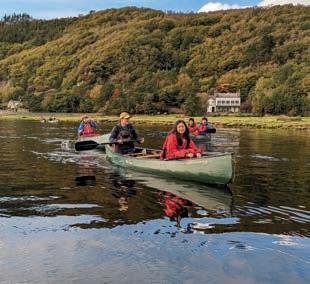
“Young people need opportunities to risk getting things wrong and to do so in a strongly supportive environment”
the benefits of teamwork, perseverance, and belief in yourself and others. We see improved camaraderie and self-worth. We watch as they learn to face new situations with confidence. The lateral thinking skills they develop can be applied to their academic studies and to their future lives.
Our programme involves every student right from day one. The school induction week features the challenge of our very own high-ropes course, an ice breaker in making friends but also a key moment to help new students warm to the idea of being challenged physically and mentally in the outdoors.
Every year group has a residential or outdoor pursuits experience, visiting beautiful environments in Wales, and Derbyshire, where they engage in activities such as rock climbing, mountain biking, canoeing and gorge walking. Our Lower School pupils (years 9-11) benefit from regular outdoor-pursuit activities as part of their core curriculum and take advantage of the beautiful local Shropshire Hills. Activities include rock climbing, mountain biking, hill walking, canoeing and high ropes.
Another element is the Duke of Edinburgh’s Award (DofE), which provides an excellent framework for those wanting to take things further, but we are careful to ensure that students who can’t commit to all of the elements of the DofE are still exposed to the excitement and challenge of outdoor pursuits.
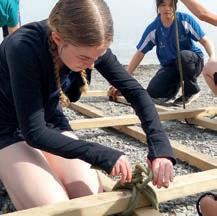
Whether the pinnacle of their achievement is a Gold DofE or navigating our local hills to arrive back for an ice cream, every student makes progress and achieves something to be proud of. One student recently recalled proudly the change in his strength, as he described the transformation from being someone who had to be helped up the hill by his team in Form 4 to being the one leading and encouraging others on a trip to Anglesey.
These experiences help our students to learn valuable skills and life lessons in an environment far removed from the classroom. Exploring problems in a practical capacity and overcoming challenges develops teamwork and refines communication skills. More than that, the experiences provide lasting memories, stories to share and a chance to view classmates in an entirely di erent light.

ORLAGH HOTCHKISS Assistant Principal (Co-curricular, outreach & inclusion) Concord College
Should
you choose A levels or the IB Diploma?
Amelia Buckworth , Education Manager at Quintessentially Education, clears up 10 common myths and misunderstandings surrounding this important sixth form choice
1. IB Diploma is harder
This is a pervasive myth, particularly in the UK. Certainly, the IBDP has a wider range of subjects to cover than the typical three or four within A levels – one of the reasons it has earned the reputation of being challenging. This is further perpetuated by student reports that some schools o ering the IBDP hand select the students deemed ‘academically able’ to study the IB programme.
Both A levels and the IBDP are academically rigorous and demanding. So, the question should be which option best suits me. While some students prefer the breadth of the IBDP, others enjoy the depth and focus of A levels. This makes it important to consider the best fit for you when choosing between the two.
2. A levels narrow learning options
This is a common charge. By choosing only three or four subjects, students are forced to decide their academic direction too early. It’s true that A levels are extremely focused, but the core skills learnt are transferable to a broad range of university subjects and career pathways. A focus on specific subjects in great depth helps students who might feel overwhelmed with a broader subject load and can be useful for candidates considering specific
subject areas (medicine, veterinary science, engineering, computer science, for instance). By building an excellent foundational knowledge, well-chosen A levels provide building block towards continued learning. Many schools o ering A levels also o er the Extended Project Qualification (EPQ). This large-scale independent project on a subject chosen by the student increases independent study skills and breadth of learning. It may also count towards UCAS points, although not all universities accept EPQs so do check.
3. The IB is too generalist
One of the great strengths of the IBDP is also considered by some to be a weakness. They argue that English Literature texts, for example, can only be covered superficially because there are so many, so students don’t develop the essay writing skills required by A level. Certainly, IBDP rewards pupils who are good at everything, so if you excel at Maths, say, but are weaker at English and foreign languages, A levels might be your better pathway to top results.
4. IB is a better preparation for university
It is often said that the IBDP o ers a more rounded approach to pre-university education. The breadth of subjects and the additional components within the IBDP
foster skills such as critical thinking and interdisciplinary connections. Some say this sets students up better for the independent study that undergraduate courses require.
On the other hand, A levels also require critical thinking and are excellent at preparing for university because students typically have fewer timetabled hours than their IBDP counterparts. They are therefore encouraged to become independent learners and to organise their own time – essential skills for the approach to teaching and learning at university.
5. The IB is just for students at international schools
This is a complete myth. The last 20 years or so has seen many of the UK’s top schools adopt the IBDP, often alongside A levels. To give specifics, 200 of the 2,600 independent schools in the UK now o er the IBDP at sixth form. Those include London day schools such as Godolphin & Latymer and King’s College Wimbledon, alongside schools such as Rugby and Cheltenham Ladies’ College.
6. British universities prefer A levels
While it is true that A levels are the more traditional route to a UK university, the IBDP is a globally recognised qualification. Most British





“In many instances, you have an equal chance of entering an international university with A-level qualifications as with the IB”
universities now recognise the IBDP as equal to A levels, as indicated by the fact entry requirements are listed on the main pages of their websites (other curricula are found under the ‘international student’ sections). The key element in any university application is a requirement to meet minimum criteria for a particular course of study – both IBDP and A-level pathways determine this.
7. The IBDP is preferred by international universities
One common misconception is that you must study the IBDP if you want to apply to international universities. The IBDP is certainly recognised the world over, and its breadth means it sits well with applicants considering a Liberal Arts degree in the US, for example. But A levels are well known and respected, too.
In many instances, you have an equal chance of entering an international university. Just be sure to check for prerequisites, as breadth of subject matter may be more challenging for applications to certain regions.
8. You can’t do IB MYP and then switch to A levels
The IB Middle Years Programme (MYP) for students aged 11-16 is much less common than the Diploma in the UK (currently taught in 35 predominantly international schools). Rather like the Diploma, it focuses on critical thinking and interdisciplinary learning. In the final year of the MYP (Year 11) each student develops a personal project which is externally validated. Historically there were no written exams, as such. The MYP eAssessment was launched in 2016 and is an optional external
assessment giving the opportunity to earn an internationally recognised certificate. This can help smooth the transition for students moving from the MYP to A levels.
9. IB teaches you how to think, A levels are about regurgitating facts
This is the greatest misconception of all. Both A levels and the IBDP require intense independent study and enable students to apply to the world’s best universities. Because A-level students focus on subjects they are passionate about, they are motivated to think critically and deepen their understanding.
10. It’s best to choose a sixth form offering both
t might be tempting to keep options open and look for a sixth form that o ers both IBDP and A levels – many top independent schools do – but this isn’t necessarily your best option. Running both IBDP and A-level programmes is challenging to timetable and expensive for schools.
From a student perspective, it makes better sense to decide which pathway you want to take and then opt for a sixth form that o ers your preferred study route.
LPS Mayfair / LPS Hybrid 106 Piccadilly, London, W1J 7NL
LPS Sixth 79 Eccleston Square, London, SW1V 1PP
LPS Clapham 7-11 Nightingale Lane, London, SW4 9AH

Dr Martina Geromin, Co-founder of School Beyond Limitations, gives advice on helping children overcome the back-to-school blues
As the final weeks of the summer holidays draw to a close, many children experience a surge of anxiety in anticipation of returning to school. It’s perfectly natural to feel uneasy about the changes a new year brings – new teachers, a di erent school and classmates and unfamiliar routines can all heighten feelings of uncertainty. As a parent, you can play a crucial role in helping your child to navigate these anxieties while supporting their mental wellbeing and laying the groundwork for positive learning habits. Children thrive on routine because it provides stability and predictability. This is why any disruption to that routine can be di cult to navigate, especially as the prospect of back to school draws closer. Establishing some form of routine during the long summer weeks is advisable. During the last two weeks of the summer holidays, gently transition your child into a more structured routine that mirrors more closely what they will experience during the school year. For example, dinner, bed and wake-up schedules may have gone a little o -piste during the break, so bringing back more regular times will help them adjust








ahead of the new school year. Consistency helps ease anxiety, as children will feel more in control of their feelings if they have a pattern to follow.
Creating time for open and honest conversations is an important part of supporting your child’s wellbeing as they prepare for the new school year. Rather than avoiding the topic during the final weeks, make time to talk about returning to school but in a relaxed, unpressurised environment. This might be during a walk, while eating dinner or driving somewhere. Keep the conversation light and upbeat – ask your child how they feel about going back, what they are excited about and what they are worried about. Encouraging your child to talk little and often can really help – simply being heard and having their feelings listened to can alleviate stress and anxiety. It
also helps you to prepare ahead for any potential hurdles September may bring.
Once you start to pick up on the things your child might be concerned about, you can work on encouraging a positive mindset by reframing any negative thoughts or fears. For example, if they express worries about fitting in, making new friends, being unfamiliar with school buildings or coping academically, acknowledge these as real fears that many children have. Help them to recognise their own strengths and previous successes by reminding them of other times they felt worried where there was a positive outcome. Sharing stories of your own school experiences – both good and bad – will help to remind them that we all go through this and further normalise their feelings. Discussing the various challenges of school life will help your child to view the upcoming year as an opportunity for growth rather than something to dread.
Where feasible, take physical steps to support your child, too. For instance, if they are worried about making friends, could you reach out via the local community to find other children who are joining the school and perhaps arrange a meet up? Maybe you could look at the school’s website together and familiarise yourselves with the site layout. If your child is simply moving up a school year, get them together with existing friends periodically during the summer weeks to strengthen ties and maintain friendships.
“Discussing the various challenges and experiences of school life helps your child to view the upcoming year as an opportunity”
Take the opportunity to involve your child in fun learning activities during the final weeks of the holidays. Visiting museums, sharing books or creating fun science experiments at home is a reminder that learning can be enjoyable and takes place everywhere. Getting outdoors also does wonders for maintaining a positive mind and body. Regular exercise releases endorphins, which are natural mood boosters and reduce anxiety while preparing children for the energy levels they will need when they get back to school.
The new school year is a period of transition, so helping your child to set realistic and achievable goals ahead of the return will make it feel more manageable. For example, focus on dealing with first-day nerves rather than what the whole term will bring. Discuss their hopes, whether academic, social, or personal, and how they will achieve them. This helps instil a sense of purpose and motivation, providing the positive focus they need as they embark on this new stage in their school journey.
As the big day approaches, remember that the goal isn’t to eliminate all nerves but to equip your child with the tools and mindset to navigate change with confidence. By fostering open communication, re-establishing structure, encouraging a love for learning, and o ering both emotional and practical support, you help lay the foundation for a smooth transition back to school.
Every new school year presents a fresh opportunity – not just for academic achievement, but for growth in resilience, independence and self-belief. With your guidance and encouragement, your child can start the year not just ready, but excited about the possibilities that lie ahead.
The Wycliffe Way:
At Wycliffe College, we offer a dynamic all-through education for girls and boys aged 3 to 18. Nestled in the stunning Cotswolds, our school combines tradition with innovation, nurturing every pupil to thrive academically, socially, and personally.
» Fostering academic excellence through rigour, challenge, and a spirit of curiosity.
» Inspiring confident humility , generosity, and mutual respect in every interaction.
» Promoting social and environmental awareness , preparing pupils to be thoughtful global citizens.
» Equipping students with resilience, self-knowledge, and essential life skills to embrace their future with confidence.
» Creating a safe, happy, and supportive environment where every pupil feels valued and secure.












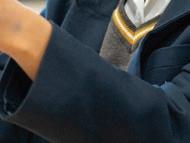





















Our experts answer your questions on summer tutoring for Common Entrance and extra support for a child struggling to focus at school

Nathaniel McCullagh
Managing Director, Simply Learning Tuition
QWe’re considering hiring a tutor during the long summer break to help our son, 12, keep on track with learning so he’s confident about forthcoming senior school entrance tests. Can you advise?
AFor families, the long summer holidays are a welcome opportunity to rest and reconnect. While this is great for wellbeing, concerns can naturally arise around the balance of rest alongside keeping children intellectually engaged. This is particularly true as your son is
“Students can lose up to two months of academic progress over the holidays”

preparing for an entrance assessment. Senior school tests are so important that you could be forgiven for skipping summer entirely. However, I would caution against this. There is so much that can be done to help improve attainment and, if your son is being put forward for the right schools, he should only need a small amount of ‘keeping up’ over the summer.
That said, summer learning loss is a recognised problem. According to the Education Endowment Foundation, students can lose up to two months of academic progress, particularly in literacy and maths. There are some simple ways to ensure that children remain stimulated. Approached with a sense of lightness, activities can be integrated into holiday time.
Reading widely is the key to success. Encourage your son to choose his own books. Talk to him about the books he’s read. Asking him about characters, plot and what he did or didn’t like will hone his analytical skills. Not all children are willing readers and, if this is the case, try playing story CDs on car journeys – audio books also require deep listening skills and concentration.
Working on platforms such as Atom Learning is fine, but I would also recommend something more
human. You aren’t just trying to pass an online test but to instil a love for learning. At some point there will be an interview and your son needs to have something interesting to say. Boys are notoriously reluctant readers and often dislike including more than the bare minimum detail in written work. With a little support, they can write and analyse material much more e ectively. Past papers from ISEB (available from Galore Park) will help hone composition and comprehension. As a parent, you can read, give comment and – most importantly – spend time with your son to build his confidence.
Back to the question of a tutor. Quite often families build in time with a private tutor over the summer. If you are already preparing for the assessments with your regular tutor, you might be able to book additional sessions. Or you can hire someone for a light-touch summer programme to keep momentum going.
A small amount of structure (2-3 sessions per week for a month, for example) could help your son return to school feeling enthusiastic and ready for the entrance tests. The right plan would o er time to plug gaps, refine exam technique and revisit tricky topics.
simplylearningtuition.co.uk

Founder, Quester Therapies
QMy young daughter is having some problems settling down to learn at school and I’ve heard that specialist therapy may be a beneficial addition to the extra help she’s now receiving from her teachers and school support sta . Can you explain more?
AIt can be very worrying when a child seems to be falling behind at school, especially when they’re already receiving extra help but still struggling. If your daughter is easily

distracted and her reading and writing skills aren’t progressing as expected, there could be underlying factors making learning more di cult than it needs to be. Specialist therapy can be a powerful complement to the support she’s already receiving by looking more deeply into the root causes and not just the symptoms.
Often, emotional and learning challenges stem from deeper neurological or physiological imbalances. These can include retained primitive reflexes (earlylife movement patterns that haven’t fully integrated), auditory processing di culties, nutritional imbalances, or even inherited genetic predispositions that a ect mood, energy, and focus.
nutrition. This is combined with kinesiology techniques to design a personalised plan that supports emotional balance, cognitive function and overall wellbeing.
Nutrition plays a big part. Many children with focus issues or low mood have underlying deficiencies or sensitivities that a ect their brain function. By working with families, we are able to explore these factors and then make gentle but e ective changes.
“Nutrition plays a big part. Many children with focus issues or low mood have underlying sensitivities that a ect brain function”
Our approach is holistic and child-centred, combining multiple therapies to support the whole child. For example, our neurodevelopmental therapy works to integrate primitive reflexes that can interfere with attention and learning. Auditory retraining, based on Dr. Guy Berard’s method, helps improve how a child processes sound – which is essential for concentration and communication.
For more complex or persistent challenges, we o er Blueprint Kinesiology, which uses non-invasive genetic understanding to identify how a child’s system is uniquely wired. This gives us powerful insight into how their brain and body respond to stress, stimulation and
Ultimately, the goal is to empower children by addressing the root causes of their challenges, rather than masking symptoms. Families often tell us they’ve tried many routes before finding us and it’s the combination of therapies, tailored to each individual child, that finally makes a di erence.
Whether your child is experiencing anxiety, trouble focusing, low confidence, or has a diagnosis such as ADHD or sensory processing disorder, integrative therapy can be a valuable complement to classroom support. We work closely with families, teachers, and also schools to ensure everyone is part of the journey. Flexible in-person and online programmes, plus an app, ensure we can be where families are, and we o er initial consultations to help discover the best next step for each child.
questertherapies.com
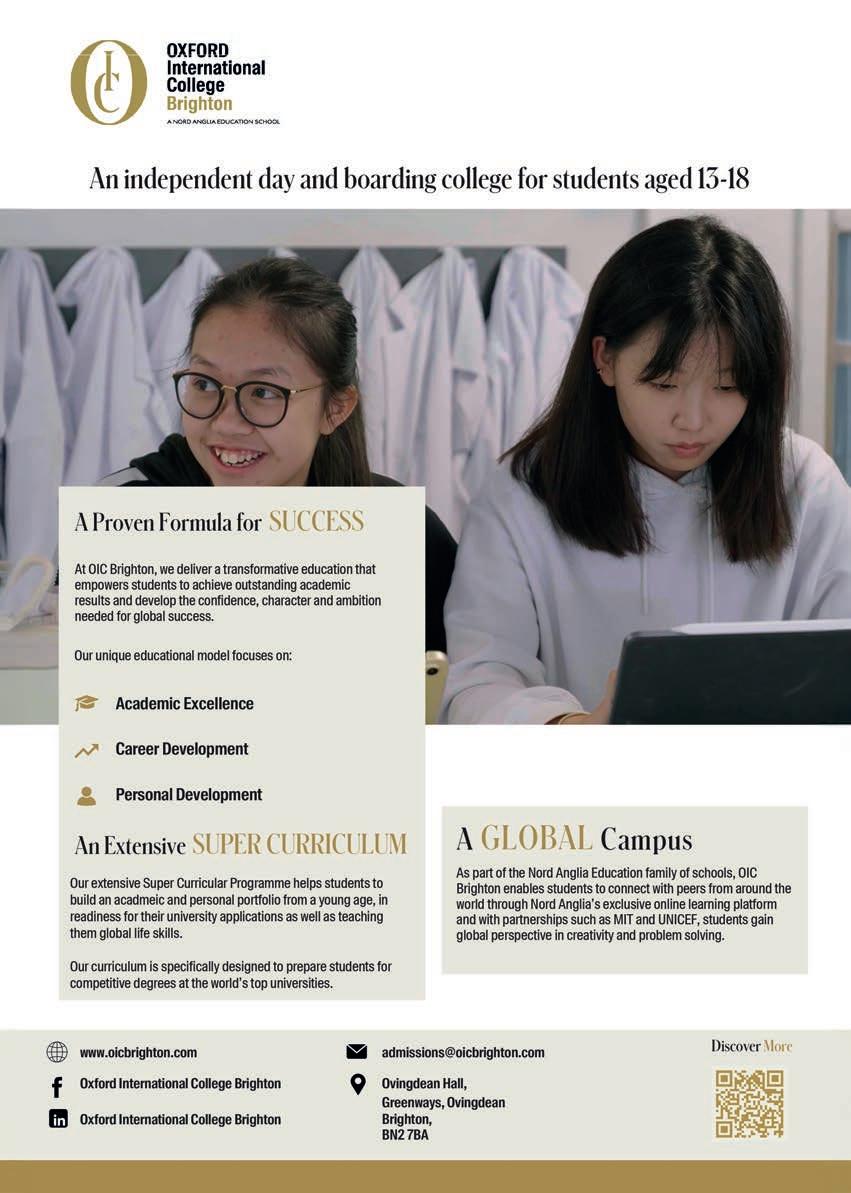



GATEWAY OF OPPORTUNITY?
A long view on Stateside study opportunities Page 101
Jess Harris, Director of Quintessentially Education, gives an introductory guide to developing a university application that stands out from the crowd
Applying to a UK university is a highly competitive process that requires careful planning and a compelling university profile. Your application should highlight your academic achievements, relevant extracurricular activities and experience, and include strong answers to the newly introduced personal statement questions.
First and foremost, your academic performance is the most critical component of your university application. It goes without saying that you need to achieve the minimum entry grade requirements for your desired course. And you need to be sure you have studied the right subject combination, too. For example, if you are applying for


engineering, having Mathematics and Physics in your qualifications is crucial, but you should also check the criteria on a per university and per course basis as some programmes might require a specific third subject. But assuming you will achieve the right grades for the course, what extracurricular opportunities will make you stand out?
The general rule is that extracurriculars you include must enhance your application, so view them as complementary to your academics for your chosen course of study and another means of demonstrating interest, skills and aptitude. As you develop your ideas of what you want to study at university, seek out extracurricular activities that demonstrate relevance to the subject or course you are interested in.
As admirable as it is that you’ve been juggling your studies while completing your Gold Duke of Edinburgh’s Award (DofE), also think about the relevance of broader achievements to this specific application. Were there learnings from an expedition that you can call upon when writing an application for Geography? Or if you’re applying for PPE International Relations and Politics, are there other community or volunteer activities that could be relevant?
As an example, highly competitive PPE courses look for candidates who have engaged with the subject beyond class, so in this instance this might include joining the Debate Club or the Model UN (MUN). In fact, the Model UN is a fantastic inschool opportunity for anyone looking
“Exploring interests beyond the classroom develops a broader understanding of the subject areas you are considering”
to demonstrate teamwork and strategic decision-making aptitudes. Students can role play as diplomats and political leaders and debate global issues by participating in simulations of international diplomatic forums such as the United Nations Security Council and General Assembly. MUN is also an opportunity to demonstrate a range of deeper skills, from consensus building to cultural empathy.
Alternatively, if you want to study in the business field, join Young Enterprise Club. Many schools now deliver entrepreneurial courses, Charterhouse is the first UK school to o er an accredited entrepreneurship diploma, Godolphin and Latymer has an extracurricular Futures Programme that is all about developing workplace and life skills. And more independent schools are o ering Mini MBAs – Oxford High School o ers students an MBA in sixth form, for example.













It goes without saying that if you see yourself in the creative or expressive arts fields, get involved with drama, art or music clubs, while budding scientists and engineers should participate in clubs and science and technology challenges. Exploring interests beyond the classroom develops a broader and deeper understanding of the subject areas you are considering. This is not only valuable for applications but also provides useful material to talk about in any subsequent interview – and, of course, supports your future university-level study.
Another great way to build your profile and get a taste for the sector you think you want to work in is to seek out a pre-university programme. University of the Arts London, for example, has courses covering creative subjects such as art and design, fine art, fashion and textile design and illustration. Not only do these courses provide fantastic
knowledge and experience but the programme also guides participants in creating a portfolio of work that can be used in the application process. Similarly, University of Edinburgh delivers summer school course across areas such as science, humanities and the social sciences, while King’s College London has summer courses for students in pathways such as engineering, medicine, psychology and law.
Work experience can prove hugely useful when demonstrating interest, so try to do as much as you can, and don’t be shy in applying to companies in the fields you want to work in. Even if your work experience is not naturally related to your subject choice, consider if there are interdisciplinary skills you have gained. Traditional leadership and volunteering roles both in an and out of school remain a valuable element. Universities still want to see applicants
who shone on the sports field, held head prefect positions or were a society president. The DofE Award also matters – it’s just no longer enough on its own to support an application in the most competitive fields. Other extracurriculars involving community service can be incorporated to demonstrate social responsibility, the ability to work in a team and commitment to completing tasks. Perhaps the best advice is to start adding extracurricular strings early. Participate in things you value and enjoy and also areas that benefit your proposed future pathway. Get outside inspiration – there are useful tips on the UCAS website, while advisors and teachers o er insider information and sound advice. Also remember to give yourself time for the application itself. As with any application or CV, compelling writing, presentation and accuracy are essential if you want to stand out from the crowd.

John
Doy of Mayfield
School stands up for the importance of arts subjects in helping young people find their talents and determine their future direction
The decline in arts subjects in UK schools is almost taken for granted these days. At GCSE, arts entries have declined 47% since 2010, with A levels faring marginally better at a still depressing 29% decline, according to Campaign for the Arts (2023 data). For some this has been a necessary correction towards more ‘useful’ and ‘productive’ ‘academic’ and STEM subjects. For others, it is a sad slide towards a Gradgrindian fact-based education system that has ceased to value creativity and artistry.
In this context independent schools are frequently seen as the last bastions of hope (or bulwarks of unfair privilege, depending on your point of view) for the arts in secondary education. Amid the rancour and class warfare, however, it is worth wondering what all the fuss is about – why do many independent schools, even with current more straitened financial circumstances, still insist on providing a broad-based education that values and cherishes the creative arts?
The answer is quite simple: the first essential step in unlocking a student’s full potential is to give them the opportunity to discover where their talents lie. It is infinitely harder for a child to do this if their daily curriculum is narrowly focused on traditional academic subjects.
At Mayfield, we don’t just pay lip service to a broad curriculum, we ensure students experience it firsthand. In Years 7 and
“The first essential step in unlocking a student’s full potential is to give them the opportunity to discover where their talents lie”

8, weekly lessons in Food and Nutrition, Art, Textiles, Ceramics, Music and Drama sit alongside English, Maths, Science, History, Geography, RS, Languages, PE and Computing. How are we supposed to find out if they’re any good at these things if we don’t give them time to try them? It’s only by giving young people the space to develop and learn skills that we give them opportunities to develop to their full potential. At the other end of the school, the work our students produce for their A levels in the creative arts is of exceptionally high quality and sees them going o to some of the best art colleges in the country.
If a child-focused argument doesn’t win the day, then how about economic home truths? Our creative industries generate £108 billion. They employ over two million people. In an epoch obsessed with growth, they have grown at one and a half times the rate of other sectors, and this despite the declining take-up, as reported by Campaign for the Arts. If time spent at school on the arts isn’t productive then I’m not sure what is. Even if students aren’t bound on a future in theatres, art galleries or on film sets, then
surely the transferable skills of teamwork, creativity, flexibility and self-confidence that the creative arts nurture so beautifully must be deemed worth investing in – especially in an unpredictable job market that is evolving with ever-increasing speed.
The benefits of a broad-based curriculum rich in these subjects are palpable on a micro and macro scale, whether you’re a dyed-in-the-wool Romantic or a hard-headed Gradgrind. Imagine what we could achieve if we had an education system that truly valued this approach and o ered it to everyone?



A war of words between the Ivy League and US administration may sound like bad news for international applicants, but Crimson Education suggests taking the long view
For decades, the Ivy League has symbolised academic excellence and global prestige. There's a high bar for entry, with acceptance rates among the lowest in the world – Yale admitted 4.6% of applicants for the Class of 2029 and Columbia 4.28%. Meanwhile, Harvard accepted just 3.6% of applicants for the Class of 2028. Yet despite these challenges, Ivy League universities remain in high demand.
International students also continue to play a key role in shaping their culture and prestige. At Harvard, the international cohort represents 16% of the undergraduate Class of 2028 and over 25% of the entire student body if you include graduate schools. Across the Ivy League, students from every corner of the world d are on the journey to making their mark on society.
Right now, no Ivy League university is under the microscope quite like Harvard. Accusations of bias, clashes with government bodies, and ongoing media scrutiny have turned the institution into a symbol of broader culture wars. But this isn’t new. Harvard has weathered storms before and emerged stronger.
After 9/11, for example, campuses across the US, including Harvard, experienced a furore centred around student intake. There were allegations students and faculty were targeted based on identity or
“Harvard remains one of the bestresourced universities in the world”

beliefs. Tensions were high, but over time, universities rebuilt community trust and reputations. Few now associate Harvard with the divisions reported at that time.
Look back further and you see earlier political controversies erupting between Ivy League and government might –from the Vietnam War and Civil Rights movements of the 1960s to McCarthyera fears over 'reds under the bed'.
Today’s backlash is arguably louder, accelerated by social media and a 24-hour news cycle. Critics have framed Harvard as a symbol of 'woke liberalism' or elitism. High-profile political figures have made the university a political target, questioning its values and credibility. While headlinegrabbing, such attacks are unlikely to diminish Harvard’s standing across the world or the enduring appeal of the Ivy League.
Harvard remains one of the bestresourced universities in the world, with an endowment exceeding $50 billion. That enables independence. In recent months, university leadership has stated it will not: 'surrender [its] independence or relinquish [its] constitutional rights'. This signals a readiness to defend core values.
In this politically charged environment, many international students report feeling anxious. Uncertainty around visas and freedom of expression has cast a shadow over what should be a time of opportunity. It is worth remembering that, despite current and historical controversies, the Ivy League continues to produce global leaders, Nobel laureates, and cultural icons. Ivy League institutions don’t just survive political headlines and headline makers, they outlast them.



















Short
courses from UKSA o er
a fast track to the ocean – perfect for anyone looking to fund travel and build transferable work skills
The UK Sailing Academy (UKSA) is renowned as a maritime training provider – o ering everything from courses to school children right up to long-term careers training for professional roles in the fastgrowing maritime industries.
For students embarking on the next stage – perhaps that year o before university or time out to think about the next step – it’s the three- and four-week courses that present an accessible opportunity. In a month, you could be on your way to a well-paid adventure. What’s more, you’ll get useful transferable job skills under your
belt, plus a potential pathway to return to and build on in the future. These short course options centre on skills that are in high demand in the industry. You can be trained to take on an entry-level role as a deckhand, steward/ess or engineer on a superyacht. It’s already a popular option with those in the know – often people who love sailing and being on the water.
Superyacht Deckhand Training, for instance, is a course that takes three weeks (August, October and November start dates) and gives you the qualification to join a crew and become responsible for the maintenance and upkeep of superyachts.
“A typical day on charter starts with full window, stainless steel and deck clean downs, followed by a mix of tasks –

including launching or recovering tender and tendering guests to and from the shore. I will then assist with navigation and taking watch while underway and dropping/pulling anchor,” says UKSA Superyacht Deckhand Training graduate Will Jones. “We run with a small crew so I will also help with repairs, interior clean downs and navigation e orts. In the o -season, I have carried out interior and exterior fibreglass repairs, painting, wood restoration – and lots of siliconing!”
A separate UKSA four-week course, Engineer Deckhand Training, is a dual role to prepare students to become versatile and useful crew members on smaller vessels. Areas covered include mooring, tender driving, maintenance and operations, with below-deck training

in routine checks, basic repairs and engine and auxiliary systems upkeep.
If front-of-house sounds more your thing then Superyacht Steward/ess Training is a course that takes up to four weeks. It’s a combination of essential safety certifications to work on board a superyacht, alongside hands-on hospitality training and soft skills development. It’s fast-paced and you are expected to deliver five-star service – everything from guest schedule planning and cocktail making to table service, housekeeping and ensuring a spotless yacht interior. There’s an optional advanced module with the British Butler Institute to provide intensive luxury front-of-house training.
For UKSA graduate Emily Preece it was an exciting journey combining everything from fireground training for the STCW (Standards of Training, Certification and Watchkeeping certificate) to learning to arrange flowers with aplomb. “Since leaving UKSA my
“There’s an optional advanced module with the British Butler Institute to provide luxury front-ofhouse training”
life has involved a lot of service, a lot of flower arranging, cocktail making and crew management,” she says.
“A typical day for me starts with answering emails, breakfast service and liaising with guests for the day’s plans. Lunch comes next, followed by cocktails and canapés before we set for dinner. Once dinner and digestif has been served and cleared, I will head back to my cabin to finish o some admin and look at schedules and plans for the next day.”
You can be ready to set sail in around a month, so what about earnings? Whether you are working for a private yacht or a charter company you can expect to take home between €2,000-€3,500 a month, with many living expenses covered. The average starting salary for a trained deckhand or steward/ stewardess is currently €2,800, while junior engineer roles are typically paid a bit more. On top of salary, crew often receive generous tips from happy guests.
The final question is – how easy is it
to get a job? The answer is that this is a growth industry, with 50,000 ships in operation across the globe and almost 600 superyachts planned for launch this year alone. There are diverse roles across the maritime industry – including cruise ships, work boats and windfarms – so there’s scope to get experience in multiple locations and settings.
The UKSA hosts open days every month where the team provide information on courses and the various industry paths, whether you are looking at a gap year working abroad or considering a long-term role in the maritime industries. Students can get informed perspectives on possible pathways, individualised careers support and assistance with CV preparation. Training is delivered at UKSA’s campus at Cowes, Isle of Wight, where students live and learn right on the waterfront.”
uksa.org











In the 2024/25 cycle: admissions consultancy

Offers to Ivy League universities



Offers to Oxford & Cambridge


Offers to the US top 50 universities
Offers to the UK top 10 universities

















At Framlingham we believe in the individual. There is no typical Framlinghamian, no singular path that we take. Often, we are many things within one. Every pupil is valued for who they are. We are a co-educational day and boarding school for ages 2 to 18 with flexi, weekly and full boarding options. Our extensive bus routes provide convenient transport for our pupils.
START YOUR CHILD’S JOURNEY TODAY
Join us for an Open Day or arrange a personal visit to experience us for yourself.
PREP SCHOOL OPEN MORNING
FRIDAY 12 SEPTEMBER 2025
SENIOR SCHOOL OPEN MORNING SATURDAY 13 SEPTEMBER 2025
SIXTH FORM OPEN MORNING SATURDAY 04 OCTOBER 2025
To register for an Open Morning, or arrange a private visit, scan the QR Code or visit framlinghamcollege.co.uk/openmornings , email admissions@framlinghamcollege.co.uk or call 01728 727217. Open Mornings run from 10:00 - 13:00.
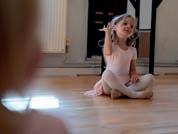
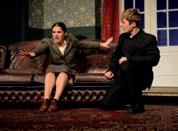




A scene from Rébecca Dautremer's extraordinary bunny biography. See page 110

Canadian author-illustrator, Jess Hannigan's bold take on goings on in the dark wood is funny, visually stunning and just a bit subversive


















Living in Ontario, Jess Hannigan is way more familiar with bears than many of her readers, but the large furry presence in her new picture book, The Bear Out There, is the opposite of alarming – rather reassuring, in fact. For this is a tale that neatly twists the Goldilocks plotline – and it is very funny indeed.
It’s the second picture book for the Hamilton-based author and illustrator – her first, Spider in the Well, featured a much smaller beastie, plus deliciously wry jokes about outrageous fibs and cons and a great quest for justice. These are plotlines for children to relish – and adults enjoy the jokes too. So does she write for this twin audience? “I do try and make fun for kids and adults because you don’t want the adult to go; ‘oh god, not this one again’.” she says. Hannigan’s love of playing with conventions began while she was at art college – in fact, a short and delightfully silly animation shared on her Instagram feed was the idea that led on eventually to The Bear Out There. Often illustration ideas start things o , but this book began with the dialogue – that classic theme of scary things out there in the darkness.
Pictures and design took over as she imagined her characters, and she started out with that most traditional art technique, collage. It’s what makes the illustrations leap o the page. Although they were painstakingly scanned afterwards, it was paper, scissors, glue to start with (a process Hannigan has also shared via a short film on Instagram). A truly oldschool messy process in our digital age, but that’s the point. “Spider in the Well was all done digitally, and most of my freelance work is all-digital as well, so I thought: ‘what is something more tactile that I can do that isn’t going to make me hate my life and regret my decision?’”
Hannigan has done plenty of fine art and large-scale canvases in her time, but as she developed her style as an illustrator, she instinctively began to pare back. “My work just got simpler and simpler as I found that this was more satisfying,” she says. “I lose interest quite quickly if there’s too much going on.”
She’s been inspired along the way by legendary names – The Big Hungry Caterpillar’s Eric Carle for one. “I’ve seen videos of Eric Carle walking through his process, and he just looked like he was having a blast painting his big sheets of paper.” She particularly

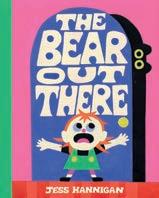
“NOT CARING TOO MUCH ABOUT CUTTING UP THE PERFECT PIECES –IT LENT A LOT OF FUN TO IT AND A BIT OF NAIVETY.”

enjoyed watching the freedom in his technique. “Not caring too much about cutting up the perfect pieces – it lent a lot of fun to it and a bit of naivety.”
She’s also a fan of other great names. “I always come back to Tomi Ungerer because of the way he lays out his page and the fun in his jokes and his characters,” she says. “And I really love Tar Gomi, the Japanese artist who does so many beautiful board books. He kind of has the brain of a designer, so I gravitate towards these design-brain people as well.”
Jess Hannigan taps into design-brain approaches herself, creating extensive mood boards as a starting point for projects – often these are on Pinterest. “Posters, lettering design, characters, sometimes it’s pictures of real animals,
but rarely.” There’s abstract art in there if colours or shapes grab her. “Once I make that mood board, I never look back at it again – I just say, ‘OK, this is the vibe’.”
And there’s a truly wild ‘vibe’ in The Bear Out There – vivid colours, retro lettering and tantalising glimpses into that dark and threatening forest to keep the reader guessing. The predominant colour palette (lots of bold pink, green, orange) has massive child appeal, and was chosen because they were the shades she was into at the time so she wanted to have some fun working with them. There is, too, the fun of a surprise plotline – children love to be surprised (again and again). She has fond memories of her own childhood bedtime stories, especially Jon Stone’s The Monster at the
End of This Book. She recalls her mother getting into character with a di erent dramatic take each time she read it out loud and wanted to create that sort of energy, that magic. Early reviews of The Bear Out There from friends with children say she’s pulled that o .
Her next picture book is already underway. No conventional fairytale beasties next time as it’s about a cow, for she has always loved drawing cows. Another book to look forward to – and surely many more to follow – for Jess Hannigan’s creations bring bags of energy and visual magic to delight readers of every age.
The Bear Out There by Jess Hannigan is published by HarperCollins Children’s Books, (£12.99). Find Jess Hannigan on Instagram at jess.hgn
9+

Nate Yu's Blast from the Past
by Maisie Chan
PICCADILLY PRESS, £7.99
Maisie Chan won awards for Danny Chung Does Not Do Maths, and she returns with another warm take on friendships and identity. Nate Yu may look Chinese, but with two white mums he's not quite sure where he fits in, despite their best efforts to engage him with his heritage. Then something extraordinary happens, thanks to a WW1 shell casing engraved with a dragon in a school history exhibition. Soon Nate is communing with a ghost called Jirou and it turns out they could do with each other's help.
MUST READ Escape
From a rabbit's life less ordinary and pirate jeopardy to world's weirdest jobs and evolution in action, here's our pick of summer reading
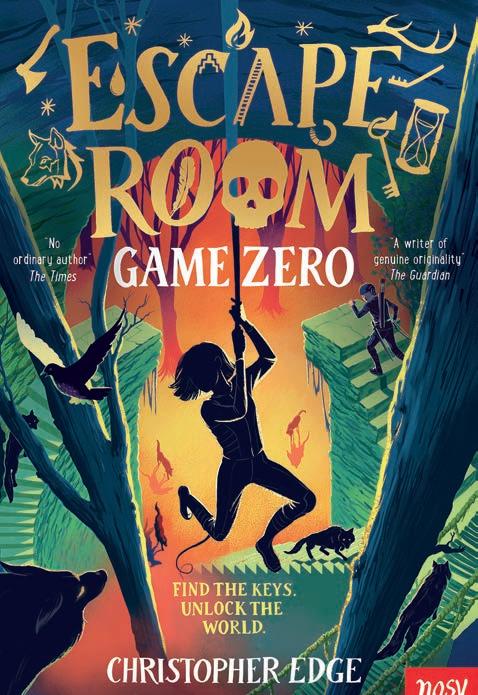
by Christopher Edge NOSY CROW, £7.99
A book for lovers of pacy adventures and games, Escape Room takes readers into a whole other realm. Eden thinks it's the end of the world when the sky turns black with a huge flock of birds. But then she is transported to The Escape, a game no one else knows about. Faced with seemingly endless puzzles, challenges and dangers, she meets fellow traveller Ted. Together they go on an epic adventure to find the keys that will finally reveal the secrets of The Escape.
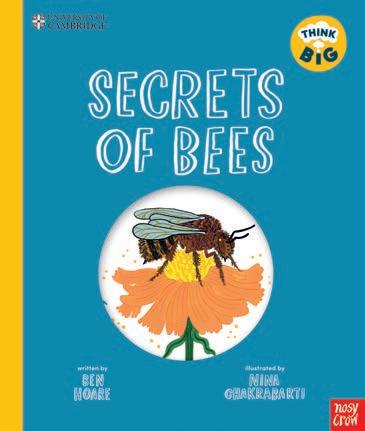
by
Donna Ashworth
illustrated by Eirinn McGuinness TEMPLAR BOOKS, £16.99
The debut children's collection by the UK's bestselling poet – delightfully illustrated by Eirinn McGuinness – brings words of comfort, hope and solidarity. There are poems about the seasons, friendships, siblings and quirkier takes on life – 'Pineapple Pizza' and 'Hopetimism' among them. Poems are light and accessible for younger readers, but don't shy away from di cult subjects. There's an index grouping poems by theme, including grief, change and emotions, and with a note for parents/carers and teachers to introduce the collection.

by Ben Hoare
illustrated by Nina Chakrabarti NOSY CROW, £12.99
Published in collaboration with University of Cambridge as part of Nosy Crow's new Think Big series, Secrets of Bees takes you inside the hive. But you also go beyond to explore the many other varieties, including miner, carpenter and the elusive Wallace's giant bee of Indonesia. The book considers life cycles, habitats, food, honey production and what it feels like to be a bee, also explaining why bees sometimes sting and providing tips on how we can all help protect our vital pollinators.

by Justin Somper illustrated by Teo Skaffa UCLAN PUBLISHING, £7.99
The third book in Justin Somper's swashbuckling series sees Barracuda Class in disarray when they discover a favourite teacher is an enemy agent for the League of True Pirates (LOT P). Our protagonists get into all sorts of hot (and cold) water in the chaos that follows. Jacoby suspects one of his classmates may be LOT P’s next target and Jasmine sets out on a dangerous sailing mission. Neo, meanwhile, follows a treasure-trail leading to a sword with untold powers. In the right hands, it could turn the tide in their favour.

This lavish book created by celebrated French authorillustrator Rébecca Dautremer has received warm praise, so it's a treat to see an English edition. It celebrates the life and times of one unassuming white rabbit through 12 illustrated scenes and longer narratives, interspersed with captioned photo-album style illustrations. We learn about Jacominus' upbringing, friendships, travels, hopes and dreams – also good times and bad. There's a dash of philosophy in the telling and it's a beautifully drawn portrait with a rich theme about living a full emotional life. by Rébecca Dautremer translated by Charis Ainslie POST WAVE, £16.99





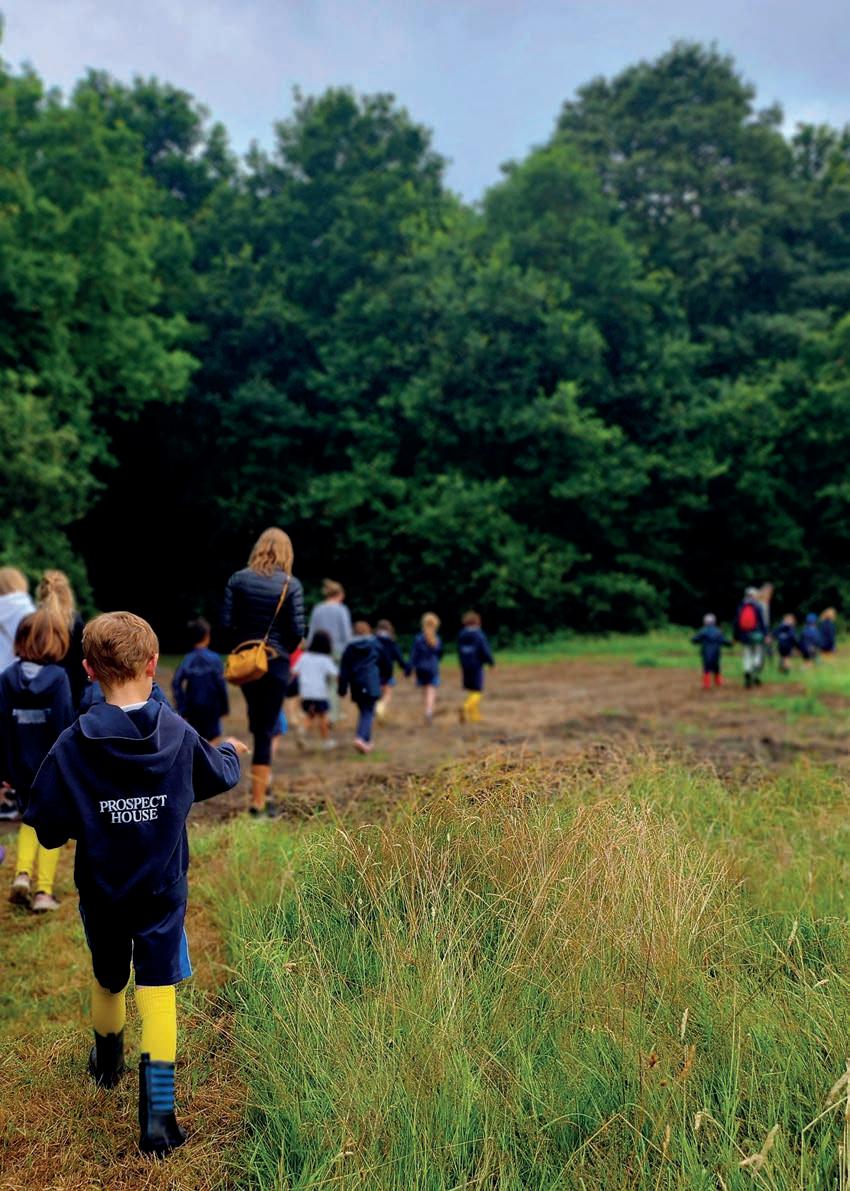








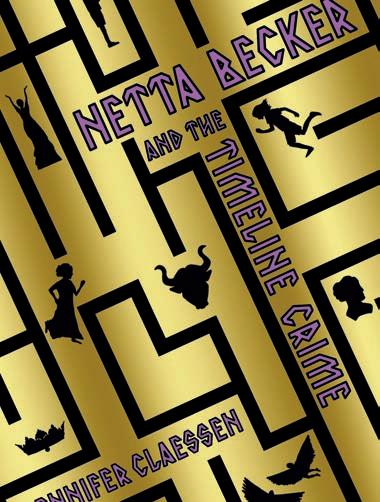
by Mike Barfield
Illustrated by Franziska Höllbacher
TEMPLAR BOOKS, £10.99
Blue Peter Award-winner Mike Barfield is back with a sequel to his book about wild inventions. This time the focus is on extraordinary, weird and downright funny jobs through history, all told in a comic-strip format. Jester, body double and stage farter are in there, but so too chariot racer, pirate and Incan runner. There's a cast of fascinating real-life characters, including Harry Houdini, Marie Tussaud, African American stunt pilot Bessie Coleman and Zazel, Victorian daredevil and the original human cannonball.

by Jennifer Claessen
UCLAN PUBLISHING, £7.99
Combining myth, sun-drenched location and adventure, Netta Becker and the Timeline Crime has a holiday flavour – perfect summer combination. When Netta and her history-mad brother Remy end up in a Cretan villa for the summer, she's not too happy. But then the vivid dreams begin and she's transported to Ancient Greece. King Minos is preparing to open his labyrinth and, with rumours of a monster inside, Netta and her brother have a mystery to solve or she could end up as ancient history herself. 5+

by Eoin McLaughlin
Illustrated
by
Guilherme Karsten
NOSY CROW, £12.99
The author of The Hug is back with a tale about the tree that became this very book. It details how the pine cone dropped from the tree, was eaten by Derek the squirrel, moved around by Barbara the beetle and finally put down roots to grow. Then this magnificent tree was cut down to become a story that can be enjoyed, passed on and remembered. There's an audiobook to add to the pleasures of a lovely story for young readers.

by Jules Howard
Illustrated by Gordy Wright
NOSY CROW, £14.99
Children take charge of their future in this new book by zoologist Jules Howard. Opening with 'Blob Beginnings' as Dickinsonia in the prehistoric oceans, readers choose one of three options to evolve into. The evolution options continue throughout the book and readers can get more information about its survivors (tiger, chicken, hagfish) and the many that became extinct. It's a clever approach to a complex subject, information rich and with engaging species narratives that present evolution as an adventure through time.
London'soneofakindmultilingualnurserygiveschildrena headstartinmasteringlanguagesfromearlychildhood.





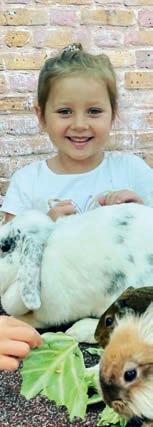



PhileasFoxNurserySchoolspecialisesinEarlyYearsmultilingualeducation, offeringchildrentheopportunitytolearnEnglish,French,Mandarin,and Russianlanguagesandcultures.
ThroughamodernEarlyYearscurriculum,wecreatetheperfectbalanceof holisticeducationandlinguisticimmersion.Ournurturing,stimulating,and play-focusedenvironmentensureschildrenthrivewhiledevelopingalovefor learning,languagesandaglobalperspective.


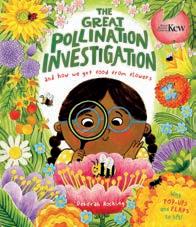
by Deborah Hocking TEMPLAR,
£14.99
Whith lush illustrations by Deborah Hocking and expert-reviewed text from the Royal Botanic Gardens, Kew, this interactive book features lots of fun pop-ups and flaps to bring the wonders of plants and gardening to life. It's a truly interactive read, with lots of fascinating science for young gardeners and nature lovers about the myriad ways pollen is spread. It includes a hands-on science investigation and instructions on how to make a special wand to explore your own garden and become a pollination investigator.

by Terri Libenson HARPERCOLLINS, £9.99
The latest book in this hugely successful graphic novel series centres on an end-ofyear camping trip for the class. These days, Emmie doesn't feel entirely invisible – well, not to her best friends or her crush, Tyler. But Joe is no longer landing great pranks as class clown. When this unlikely duo find themselves stuck together on the trip, they expect the worst, but something unexpected happens.

by Michael Hall HARPERCOLLINS, £12.99
Subtitled 'A Story About Kindness', this book has fun illustrations and minimal text – and the story does pack a powerful punch about the value of empathy. Badger is not coping at all well, for he starts bullying his friends Frog, Moose, Elephant and Bear. While it would be easy to retaliate in kind, they get together and teach him a lesson about kindness. Then, when Bear needs a little extra support, Badger comes good as a friend.

by
Joseph Elliott illustrated by Nici Gregory PICCADILLY PRESS, £7.99
The sequel to Nora and the Map of Mayhem sees our grey-haired protagonist called on to save the day, again. When Nora gets invited to a fancy dress party she thinks that's the worst of it, but then her friend Grizzler goes missing. After she finds his boat wrecked, she launches a rescue mission – only she doesn't expect the great-grandchildren Atticus and Autumn to be on board as stowaways. With monsters and dastardly villains to overcome, our OAP dynamo shows the young ones how it’s done.








A day and flexi boarding school for girls and boys aged 3 to 13. Conveniently located near the A3 and M25, and with daily bus routes from South London and the southern Home Counties, Feltonfleet is a rural oasis amongst the urban hustle, where children are encouraged to use their imagination, think creatively, explore the world around them and strive to excel. Arrange a visit to find out more. www.feltonfleet.co.uk








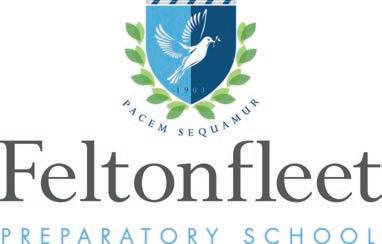

Author Meg Grehan returns to a much-loved cast for her new novel, and she remains convinced that the verse form helps to make sense of growing up
Meg Grehan is the voice of the trusted confidant you wish you'd had when you were young.
Writing novels in verse form, she's found many fans because of her ability to express the highs and lows of what it feels like to be growing up, and to be human. Her new novel, The Brightest Star returns to a cast of characters readers first met in The Deepest Breath. Now Stevie, Chloe and Andrew are starting secondary school. Stevie and Chloe are closer than ever they were – they know they like each other –but Andrew is pulling away from them. Revisiting these characters was not
something Grehan had planned, but all that changed when theatre company Treehouse Shakers staged The Deepest Breath in New York a couple of years ago. She loved the production so much she felt she had to continue the characters' story.
Writing has been a constant for Meg Grehan. First published in her early 20s, a decade on she now has five novels under her belt. "I wrote a lot as a child and as a teenager – it was kind of a constant thing," she says. "When I got to college I just stopped. I didn't have the time, and it became less of a priority. And then I became agoraphobic."
It was at this point she sat down and wrote her breakthrough book – The Space Between – and the characters and themes helped her deal with what was going on in her own life.
“ Poetry, when you're writing it, you write in the breath and in the pause, so it really guides you”
"I'm much, much better now," she says. "I am not resentful about it. It's because of that I wrote my first book about an agoraphobic character." She is mindful, though, about how she discusses writing's impact on her own recovery. "I try to be careful talking about it because I don't want ever to imply writing can replace therapy," she says. "But it can help you figure things out. If I can give a problem I have to one of my characters and help them work it out, and have empathy for them, it helps me have empathy for myself."
Grehan addressed her fears writing the first book, and then she faced them down getting it published. "The first time I left my house was when I got the email saying that Little Island wanted to publish The Space Between," she says. "Oh, it was massive! I had to go from Donegal – from the tippy top of the country – to Dublin." Success, awards and a big international audience followed. The writing comes naturally, a process she describes as "getting it out of your head". Verse also comes naturally – partly because of how she created her first novel. "I was alone a lot, and I was trying to write this book about mental health, as they all are, and it felt like a lie to have so many words."
It felt like the best way to convey meaning, but then she has always loved poetry. "Our lives have lots of poetry from when we're little. Picture books are poetry; nursery rhymes are poetry. We sing lullabies – is that not a poem? There's a rhythm to life when you're a kid."
Echoes of that comforting rhythm are ever present in her work. "Poetry, when you're writing it, you write in the breath and in the pause, so it really guides you."
Just as Meg Grehan is guided by the breath and pause, so too her readers. She brings comfort by describing clearly and calmly the often bumpy and sometimes lonely journey of growing up.






The Brightest Star by Meg Grehan is published by Little Island (£9.99).

Wetherby Preparatory School in central London is an independent day school for boys aged 7 to 13. Known for its exceptional education and pastoral care, the school has a proven track record instilling in students the leadership, confidence, and global citizenship skills they need to flourish in a changing world.
www.wetherbyprep.co.uk

View over Ladram Bay, Devon. See page 120
From family fun and wild adventure to adults-only escapes, the UK offers a huge choice of camping options. We asked the experts at Pitchup.com to pick six treasures for an idyllic summer break

Forget close to the waves, this site in Budleigh Salterton, Devon boasts its own stretch of sand. It’s an idyllic spot where you can enjoy rockpooling and fishing or hire a kayak, rowing boat or motorboat and venture out to sea. Refreshments are also available – including doggy ice-cream, which pooches are welcome to enjoy from the decking although they are not allowed on the beach itself.
This iconic bay has a sand and pebble beach, backed by red Devonian sandstone cliffs, with views across to two further stacks. It sits within the East Devon AONB, and the South West Coast Path runs directly past along the fossilhunters’ favourite Jurassic Coast.
While Devon’s scenery and cream teas offer good reasons to get out and explore, there are a good range of activities on site include a large pool complex with splash zone, indoor and outdoor play areas, crazy golf, games and amusement arcades. Usefully, there’s a supermarket, restaurant and takeaway. Pitch essentials: Electric grass tent pitch for up to 6 people from £20 per night.
Located in a secluded south-facing field with simple facilities, this farm camping site scored a full ten out of ten in reviews from guests staying in 2024. Young children can spend time feeding and petting the resident alpacas, goats, sheep, chickens and rabbits, and it’s a great opportunity for them to learn about animal care and farm life.
If the animal magic wears o or they need to let o steam and make a noise, there’s also a handy secure children’s play area with tennis rackets, space hoppers, footballs and nets.
There are just six pitches (for tents, touring caravans or motorhomes), as well as toilets and a shower, dish washing area and a small on-site shop for freshly laid eggs and logs for the campfire.
Located around 20 minutes south-east of Chester, the site is close to a host of family-
friendly attractions including the Ice Cream Farm at Tattenhall (the world’s largest ice cream shop with indoor and outdoor play attractions). There’s also the Crocky Trail, a mile-long adventure path with additional slides and rides. Both are within ten minutes’ drive of the campsite. Chester Zoo is under half an hour’s drive and the city itself has medieval galleried shops, Roman history and city walls to explore.
Pitch essentials: Pitches for up to 6 people from £30 per night (2-night minimum).

Holidaying with other families keeps everyone entertained. To up the pleasure, head to a smaller glampsite where your group can have exclusive use. Hengrave Meadow Glamping, on the edge of a pretty village in rural Norfolk fits the bill perfectly, with three fully furnished bell tents, each sleeping up to four, in a gorgeous meadow with small pond. Wellbehaved dogs are welcome, too.
Each tent comes with its own covered outdoor kitchen equipped with camping stove and utensils plus a private shower and toilet in a converted shepherd’s hut. There’s a communal pot wash and fridge in a converted stable with power points for charging phones – you’ll also find a small library there.
Hengrave Meadow is 30 minutes from the Norfolk coast, the ‘fine’ cathedral city of Norwich and the Norfolk Broads, making this an excellent base to explore the county of big skies. The nearest shops and pubs are in Reepham, half-an-hour’s gentle cycling using one of the courtesy bikes.
Nearby attractions include dinosaurthemed adventure park ROARR! (seven minutes’ drive). BeWilderwood treehouse and play park and Pensthorpe are close by. Pitch essentials: Bell tent for up to 4 people from £150 per night.



Escape the everyday, and the children, with a stay at a luxury shepherd hut located on a 270-acre farm in the Chilterns. There are two huts, each containing everything needed for a cosy break for two, including a double bed, ensuite shower and a kitchenette with microwave, hob, fridge and kettle. Outside, each hut has a delightfully private wood-fired hot tub.
The huts’ namesake red kites are in abundance in this part of the world, so it’s worth taking binoculars for a closer look, although dozens can easily be seen performing acrobatics overhead. Skylark and curlew are regularly spotted thanks to the owners’ commitment to schemes that support ground-nesting birds. Other local wildlife includes barn owls, kingfishers, otters, hares and deer.
There are plenty of walks and trails close by, including a link path to the Phoenix Trail cycle route. Guests can also fish on the River Thame, which runs through the farm. For o -site treasures, Waddesdon Manor, Cliveden House and Blenheim Palace are all within half an hour’s drive. For a real treat, book in to Le Manoir aux Quat’ Saisons – just ten minutes’ away – for a Michelinstarred meal.
Pitch essentials: Shepherd hut from £280 per stay for 2 adults (2-night minimum).

If exploring stunning (and uncrowded) beaches and hiking remote trails before building a campfire to cook up dinner sounds like a perfect way to spend quality time with the family, head for the Afan Valley to this family-run spot known as ‘The Great Welsh Adventure’. Located on top of a hill inside the Afan Forest Park, with far-reaching views over the surrounding terrain, there’s an extensive hand-built wooden play area on site as well as a bar and regular live music. Amenities include a shower block and washing-up cabin, and there’s also an undercover barbecue area with hanging
barbecues and tables – handy if the temperature drops or the rain falls. There are spectacular walks and mountain bike trails to explore from the site. Alternatively, go for adrenalin experiences by ziplining at Zip World Tower – home to the world’s fastest zip line and the UK’s only underground bouncy playground. Hiking and horse-riding opportunities in the Brecon Beacons add to the adventure of a stay here. Complete a family challenge with a walk up, Pen Y Fan, the highest mountain in South Wales, or spend a day on the Six Waterfalls Walk to see the full force of nature.
Pitch essentials: Non-electric tent or motorhome pitch for up to 5 people from £22 per night.
Close to standout attractions, including Clearwell Caves in the Forest of Dean, this site has plenty to see and do whatever the weather. With a free gym, sauna and steam room, as well as an indoor pool with a kids’ area, basketball court, mini golf and plenty of walks and cycle routes, daytimes can be filled with water and woodland fun. Evenings are sorted too, thanks to a choice of on-site restaurants and live entertainment.
The site is popular with camping regulars and welcomes all varieties of camper and glamper, with pitches for campervans, touring caravans and tents. Four-legged visitors are welcome – the dedicated dog exercising area even has a canine assault course. There are also plentiful great walks on and around the site.
The local area o ers plenty to see and do, from iconic Tintern Abbey to canoeing or kayaking along the River Wye at Symonds Yat. Under two hours’ drive from Birmingham and 40 minutes from Gloucester, this is a popular stop-o point for tourers journeying on to South Wales, Devon and Cornwall. Pitch essentials: Pitch for up to six people from £28 per night.
To book these sites or search more than 6,000 others listed by location and special features, visit pitchup.com
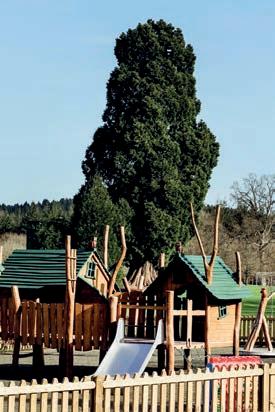






The most beautiful beach and a gloriously relaxed vibe make Turks and Caicos irresistible – especially as guests of Wymara















Turks and Caicos Islands delivers a Caribbean experience without the crowds. This ribbon of 40 islands and cays, eight of them inhabited, sit south of the Bahamas in the Lucayan Archipelago – so geographically within Atlantic not Caribbean waters. While low key for tourism, Turks and Caicos punches above its weight for plaudits – notably, topping multiple lists for world's best beach at Grace Bay.
We are guests of Wymara Resort + Villas on Providenciales (locals call it Provo) giving us direct access to this celebrated beach. Like Turks and Caicos, Wymara is a heavy hitter for awards. You'll fi nd it on all the best lists, including Forbes, Tripadvisor and Conde Nast Traveler. Guests rave about serenity and superlative service in a picture-perfect romantic location. We're lucky guests indeed, experiencing both its luxurious villas and the boutique resort, a few minutes' drive away.


Even arriving at Providenciales Airport feels like stepping down a gear. We've been advised not to bother with a taxi because everyone takes the minibus – and so we join returning islanders and visitors, a convivial crew happy to be paradise side. Everyone knows Wymara Resort, but the Wymara Villas + Beach Club is newer and there's some debate among our fellow travellers as to where precisely it's located. Thankfully, our driver knows the way – we're dropped o with happy holiday wishes within minutes. As arrivals go, this couldn't be easier, and so it continues. After the swiftest check-in, we're whisked up the hill by golf cart to our one-bedroom pool villa by our personal concierge. Our sun-drenched space is dazzling, ultra-modern and sleek with total privacy. Doors open to our outside deck – ultimate serenity spot with dining area, private plunge pool, shady loungers and views of glittering blue ocean just down the hill. Inside, the villa is a design marvel with a huge ocean-facing bed, cosy sofa plus a kitchenette so well imagined that we could cook up a feast, should we so desire. The








bathroom gives more superb views of the blue ocean below from its walk-in shower.
Refreshed after a quick dip in our private pool, we head out to a reception and dinner at one of the six-bed villas recently added by Wymara. While our space feels roomy, this is positively palatial – huge pool, incredible entertaining spaces and direct access down to the ocean via private steps. We are treated to a lavish feast created by the inhouse chef team before retiring replete.
Next morning, breakfast gets delivered discreetly to our hilltop deck and then we head down to the chic Beach Club, where energetic souls swim laps, play tennis or try pickleball. We're tempted by the fantastic in-ocean pool. Accessed down wide steps from the jetty, it's a vast and deep seawater marvel hewn from rock. You can swim lazy laps to your heart's content and then recharge at the Tiki Bar, where food and drinks are served all day. Sundowners here provide the best sunset views.
One evening, before heading out, we have a sound bath therapy on our deck. It
is an out-of-body experience that leaves us simultaneously relaxed and recharged. This, like all the spa treatments, comes to your villa if you don't want to go to the spa. Sustainability and healing are key tenets, with treatments from beauty-insider favourite 111SKIN from London and islanddeveloped Wildflower Skincare Lab. With the latter, flowers used in products are grown right here on resort.
Sustainability is a top concern resortwide – and with Green Globe Certification to prove it. There are generous ongoing Wymara contributions supporting initiatives to maintain what makes Turks and Caicos unique – including its spectacular reef system, third largest in the world. No visitor to this pristine environment would ever argue with that.
After a couple of days in idyllic villa seclusion, where we don't need to lift a finger or go anywhere (we're reliably informed that's precisely what a fair few guests come here to do), we move Resort side to an Oceanfront Suite. This is another brilliantly designed space, with vast living room and kitchen and
separate bedroom with double-height doors you can close (useful for hosting guests). There's a glamorous in-bedroom bathtub for leisurely soaks, with wonderful bathroom adjoining. But the biggest luxury is the uninterrupted ocean vista from our terrace.
Amazing Grace Bay Beach – there is no better description. It is vast, curved and wide, and stretching into what seems like infinity in both directions. It has the softest sand we have ever walked on and is blissfully uncrowded. There are swimmers and loungers dotted about and couples walking the shore – it's a dreamy stroll along this beautiful bay with its vivid blue waters.
Life at Wymara Resort happens on or around the beach, unsurprisingly. Pink Bar o ers the best cocktails and a great bar menu fresh from the laidback Blue Water Bistro right next door, while the cosy loungers and fire pit beyond – plus regular beach barbecues – tempt guests to linger barefoot in the sand long after the sun sets.
For even finer dining, Indigo is top-rated across the island and far beyond, with multiple
"Amazing Grace Bay Beach – there is no better description – has the softest sand we have ever walked on and is blissfully uncrowded"




culinary awards. Menus o er delicious fish and seafood specialities, always with emphasis on provenance and sustainability (Australian executive chef Andrew Mirosch is also an avid fisherman). There's a brilliant range of vegan and wellness options, too, and simply everything – from shrimp and local mahimahi to the fabulous array of steaks – is on point for taste and presentation. The dessert menu deserves special mention for housemade ice creams and sorbets, chocolate lava cake and deconstructed bano ee pie – divine indulgences one and all.
In fact, divine indulgence is the best way to describe Wymara. Whether you are resort or villa side or (like us) experience the pleasures of both, this is an enchanted retreat on the most beautiful island. It delivers perfect down time – quietly luxurious, supremely relaxed, and with the softest sand and bluest ocean. And yes, amazing Grace Bay deserves that crown for world's best beach.
* Rooms from £631, inc breakfast. BA flies to Providenciales via Nassau. wymara.com



Billund in Denmark is the home of Lego – and it’s an excellent family destination for fans of the brick
PENDLE HARTE





At the gate at Heathrow we’re surrounded by small children. It’s the fi rst week of the Easter holidays and there’s only one reason for so many families to be flying to Billund, a small airport in the rural east of Denmark. In fact, it’s the same reason that the airport exists. Billund is the home of Lego, and the enduring appeal of the plastic brick has made this small town into an international destination. And today, the airport that was originally built to take Lego all over the world is now used to
bring people to Lego. Not only is this the gateway to Legoland, but also to the newer Lego House, a vast ‘experience centre’ dedicated entirely to the humble brick. Thanks to Denmark’s e cient public transport system, we’re in the centre of Billund just a few minutes after landing. Actually, we could almost have walked here. Expecting Billund to be entirely Lego-themed, we’re a bit surprised to fi nd that there are no Lego street signs, theme cafes, shops or even billboards. Instead, it’s a small, quiet place – quite short on restaurants and bars and dominated by a vast white monolith that turns out to be



the Lego House. The Legoland theme park is on the outskirts of town, with its own hotel and eateries. Our hotel, The Lodge, is comfortable and surprisingly lacking in any references to Lego, though we all know that everyone is here for the same reason. Once inside the Lego House, it all begins to make sense. It’s a whole Lego world, brilliantly presented to appeal to all ages, obviously to people already obsessed with Lego, but also to people who aren’t. It is a vast and cleverly designed building, a series of staggered blocks that itself resembles a series of Lego bricks. Inside the light and airy space are 25 million lego





pieces, most of them here to be played with, spread over di erent colour-coded zones in light-fi lled areas. It could so easily be hell for parents and overwhelming for children, but thanks to its ingenious design, it’s not.
You need a whole day to visit really, because there are so many things to do. We start in the basement, where there’s an exhibition about the history of Lego. It’s a good story, and advertising artwork from the 1980s, ‘90s and ‘00s will be familiar to most of the parents visiting. In brief, Lego was founded in 1932 by Billund carpenter Ole Kirk Christiansen and, by 1980, it had become a global leader in the toy world.

On the first floor, there’s a spectacular model world in Lego. Elaborate miniature street scenes include cityscapes with moving trams, trains and buses; cranes and construction activity, fairgrounds with moving rides and flashing lights, ports with shipping containers loading and unloading, ski resorts with working cable cars, river cruises, helipads –and everywhere are busy little Lego people sitting in cafes, getting into cars, buying flowers, sunbathing on rooftops, putting out fires, driving ambulances and loitering on Lego pavements. The detail is mindblowing.
Then there’s the stop-motion station, where we have 15 minutes to create a small film at individual stations, each with a selection of backdrops and various figures and costumes to work with. We choose the jungle, and are proud of our stop-motion version of I’m a Celebrity, complete with Ant and Dec, plus a few colourful characters arriving in style. Other activities include making lego fish and scanning them into a digital aquarium, constructing Lego flowers and adding them to a large display, and programming Lego robots. Everywhere are small Lego vignettes: recreations of historical interiors, say, or model trees made of millions of bricks, or enormous Lego dinosaurs, and there are lots of pieces submitted by Lego fans all over the world. A vast Lego waterfall is built from almost two million bricks. Various stations – known as Creative Labs – allow for free play with more bricks

than anyone has ever had access to before, whether children want to contribute to communal creations or work on their own. And when hunger calls, there’s a Lego cafe, sta ed by Lego robots that deliver your food in large plastic bricks, and everyone takes home a small chef minifigure.
We leave with small paper bags containing freshly made Lego pieces

‘Lego is a language’, they say, and with its infinite potential for creativity and innovation, they’re not wrong”
that we’ve witnessed coming o a mini production line. ‘Lego is a language’, they say, and with its infinite potential for creativity and innovation, they’re not wrong. We spend the best part of the day at Lego House, and as we exit the lift on the roof into the sunshine, the building comes into its own. Brightly coloured zones on di erent levels are dedicated as a series of playspaces in what feels like a futuristic otherworld with striking architectural beauty. Set against a blue sky, it’s an impressive sight.
The next day we brave Legoland, which is a more relaxed version of the Windsor theme park – of which we have varyingly positive recollections – but we much enjoy the model village. This includes the Taj Mahal, the Pyramids, the Ei el Tower and other global icons alongside miniature versions of innovative modern European housing developments. Copenhagen’s Royal Palace and a working model of Billund airport itself, are among them. The rollercoasters are fun, the queues are minimal and the whole experience is great. No wonder we encountered all those families at Heathrow –they knew that Billund is the place to be.
legohouse.com
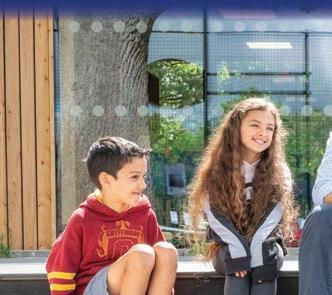










Visit www.sexeys.somerset.sch.uk | Email admissions@sexeys.somerset.sch.uk State Boarding
From £5,381 per term, No VAT on fees
“Pupils thrive at Sexey’s School. They are happy and safe.”
Ofsted 2023
Sexey’s School is a league-topping, Church of England, co-educational state boarding and day school for 11-18 year olds. Weekly boarding places available for September 2026. Families are welcome to visit and tour the school during term time by appointment.














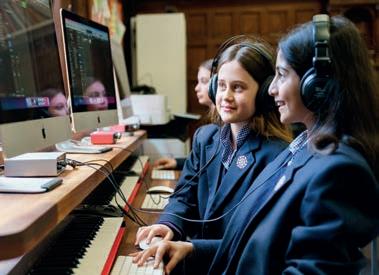
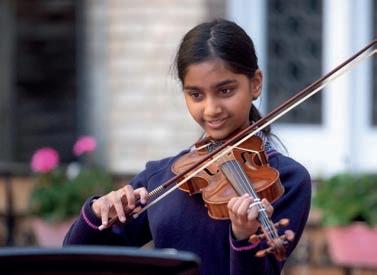


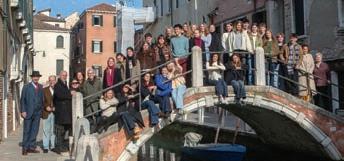




At Sarum Hall School we believe that the spirit of every child should be nurtured; that happiness gets results; and that success is ensuring every girl achieves their personal best.
We are a modern, independent girls prep school in London’s Belsize Park. We focus on each girl as an individual, and inspire them to fulfil their potential and encourage them to achieve excellence.
Individual talents are nurtured, and we instil a strong sense of purpose to every girl, allowing them to explore our wonderful world with confidence.
The foundations set at Sarum Hall School will last a lifetime.
Miss K Coles - Headmistress Sarum Hall School 15 Eton Avenue, London NW3 3EL 020 7794 2261
admissions@sarumhallschool.co.uk www.sarumhallschool.co.uk




registrar@fhs-sw1.org.uk www.fhs-sw1.org.uk 020 7730 2971

Climbing,

Start

Sixth
Scholarships
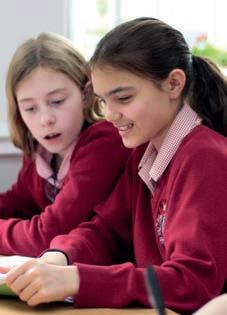








with 60
The Headmaster of Wycli e on his background and educational philosophy
What is your background?
I was a financial PR consultant then did o cer training at the Royal Military Academy at Sandhurst. I became an o cer in the Royal Green Jackets, which later became the Rifles, and served in Iraq. After leaving the military, I became a geography teacher and housemaster at a boarding school in Oxfordshire. I was there for 11 years, then moved to a school in Yorkshire as Senior Deputy Head before joining Wycli e.
What excites you most about your role?
It’s a pivotal time for independent schools and what excites me is tackling the challenges and opportunities before us head on. Wycli e is a community which leaves no stone unturned in developing the best education for all abilities across a variety of disciplines. Opportunities are abundant here and all pupils are encouraged to have a go. Ambition for what we all can achieve – pupils and sta alike – is at the core of all we do. People have preconceptions about independent schools, but we want everyone to take a look behind our doors and see what we are doing.
What is your academic philosophy?
It’s about developing our children before we let them out into the big wide world – providing the opportunity to see what’s there and what might interest them, where they might excel. We need to take into account pupils’ individual learning needs but also ensure they don’t see limits to what they can do. We need to know their strengths and provide the environment to nurture those talents. It is important to keep that motivation at the centre – something which can be integral to unlocking a child’s potential and setting them up for their future.
Can you tell us about one pivotal moment in your career?
Becoming housemaster. I enjoyed the opportunities that boarding gave

me to positively influence the lives of pupils and colleagues. I’ve worked with inspirational leaders and Heads, all of whom demonstrated a wonderful sense of humanity and drive to do their best, and in whose footsteps I wish to follow.
What is your school’s approach and what sets it apart?
I love the grounded unpretentiousness, where everyone from the age of two to 19 is known and valued. What sets Wycli e College apart is a focus on holistic development of the child. We don’t set any
boundaries but look at the whole person, the character of the individual, when we accept pupils. We adapt to their bespoke needs –from academic to sport, music and employability – to ensure a high level of achievement. Our pupils leave us as resilient young people who are ambitious for themselves and what they want to achieve in life.
What makes a great student?
Kindness, a willingness to learn and embrace di erence and display unassuming confidence.
From your experience, what makes a great school environment?
A great school environment has experienced, innovative and caring sta combined with specialist departments and facilities that create a welcoming but also engaging and vibrant community full of opportunity. Happy children get more out of school, but a good school pushes itself to really engage children, helping them see what they are capable of. That passion, fostered early for education and growth, leads to a lifelong and inbuilt confidence and core abilities that are invaluable.
“Our pupils leave us as resilient young people with the confidence to be ambitious for themselves and what they want to achieve”

South London's leading co-educational day school
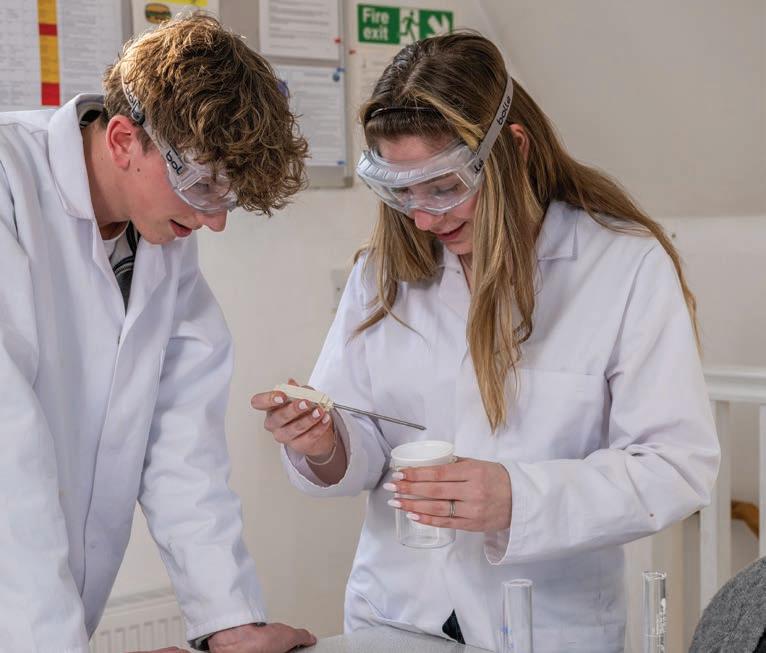
When it comes to a good education, one size does not necessarily t all. At MPW, one of the UK’s best-known names in fth and sixth-form education, we have been offering a distinctive alternative to traditional schools for 50 years.
A levels and GCSEs in over 40 subjects, plus retakes and Year 12 transfers
Personal tutors providing individual academic and pastoral support
Oxbridge-style tutorial groups with nine students or fewer
Excellent results and progression to top tier universities
Best in class inspection reports from the ISI and Ofsted

e small class sizes were hugely bene cial to my learning, providing an excellent foundation for a strong professional relationship between students and teachers.
James achieved A*A*A* at A level and is now reading English Literature at the University of York